
Chronic Conditions & Holistic Health
Spring is in the air, and with it comes the blossoming of our favourite flowers, the greening of the trees, and, for many of us, a less welcome arrival—the season of allergies. You’re not alone if you find yourself amidst a chorus of sneezes, itchy eyes, and endless sniffles. While over-the-counter medicines have been a go-to for many, some allergy sufferers find these remedies less effective over time. Before resigning to a season of discomfort, consider exploring alternative medicine, which may offer new hope for your seasonal woes.

The Changing Tides of Allergy Relief
Allergy season can seem like an annual battle for those sensitive to pollen and other environmental triggers. At times, the medications that once granted relief don’t seem up to the task anymore. This is where alternative healthcare approaches come in. It offers novel methods to ease allergic reactions by addressing the body as an interconnected system rather than just treating symptoms.
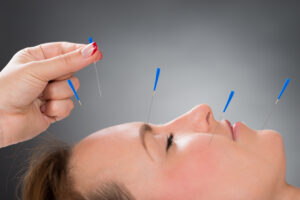
Acupuncture: A Point in the Right Direction for Allergy Sufferers
Acupuncture’s role in allergy care garners increasing recognition as a substantial body of clinical research confirms its benefits. Applying fine needles at precise acupoints stimulates the body’s healing processes, gently urging it toward equilibrium. This ancient practice has transcended time, offering a holistic alternative that complements modern medicine. Particularly for those grappling with seasonal allergies, studies show acupuncture can reduce inflammatory markers, enhance pulmonary health, and fortify the immune system. These attributes make acupuncture a plausible choice and a profoundly impactful one in our continuous quest for well-rounded allergy management.

Considering the pivotal role that gut health plays in our overall wellness, naturopathic medicine emphasizes dietary modifications as a foundational step to a balanced immune system. A significant component of our immune defence is in the gastrointestinal tract, so it makes sense that a healthy microbiome can influence our immune resilience.
Incorporating probiotics into one’s diet through supplementation or fermented foods is a research-backed strategy for enhancing gut flora diversity and functionality. This bolstering of the microbiome can profoundly affect the body’s immune responses, particularly regarding allergies, often resulting in reduced severity of symptoms.
Comprehensive allergy testing is an integral part of this whole-person approach. Individuals can more precisely tailor their lifestyle and dietary choices by identifying specific allergens. For instance, quercetin, a natural compound found in many fruits and vegetables, has been known for its antihistamine properties. Meanwhile, vitamin C acts as a natural antihistamine and immune system booster.
Talking to a knowledgeable naturopathic doctor can help you manage your allergy symptoms naturally. By picking the right supplements and keeping your gut healthy, you can take care of your health in a lasting and balanced way.
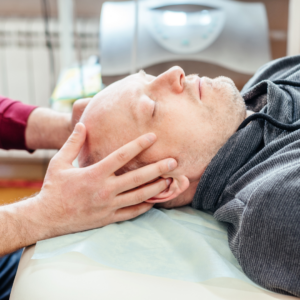
Manual Osteopathy: Breathing Easier Through Allergy Season
Osteopathy offers a unique approach to health care that views the body as an interconnected system. Its techniques address and resolve a myriad of health issues with care and precision. Notably, contemporary research substantiates osteopathy’s effectiveness in enhancing respiratory health, proving especially beneficial for individuals suffering from allergies. Through targeted manipulations, osteopathic practitioners adeptly increase airflow and rib cage flexibility, providing substantial relief from constricting symptoms like nasal congestion and chest tightness.
Incorporating osteopathic care into an allergy management plan has gives comprehensive relief, complementing conventional treatments. By improving the structural integrity and function of the body, these specialized techniques mitigate the discomfort associated with allergic reactions. It is this constructive collaboration of osteopathic practices with traditional methodologies that empowers allergy sufferers to breathe easier and live more comfortably. The strength of osteopathy lies in its ability to not only alleviate specific symptoms but also to bolster the body’s natural healing mechanisms, affording patients a more dynamic path towards wellness.

The Traditional Chinese Medicine (TCM) framework, views allergies as a pivotal signal from the body, indicating deeper disharmony. TCM suggests that the root of allergic responses lies in the dysfunction of qi, or vital energy, particularly within two critical organs – the lungs and spleen. The lungs, in TCM, serve as the first line of defence against external pathogenic factors playing a vital role in the immune response. Strong lung qi implies a robust shield against allergens, minimizing the likelihood of hypersensitive reactions. Conversely, when lung qi is weak, the body’s ability to filter out pollen, dust, and other allergens diminishes, exacerbating allergy symptoms.
Furthermore, the spleen in TCM is associated with the digestive system and the transformation of food into energy and nutrients. A well-functioning spleen contributes to the production of healthy qi and bodily fluids. However, spleen qi deficiency can lead to an accumulation of dampness and phlegm, creating an environment where allergies can thrive. This interconnection illustrates why TCM stresses the importance of holistic healing, focusing on bolstering the lung and spleen qi. Practitioners achieve this through acupuncture, herbal remedies, and dietary modifications. By targeting these specific qi deficiencies, TCM aims to rectify the underlying imbalances, thus providing a long-term solution to allergy sufferers and enhancing overall well-being.

A diet amply furnished with specific nutrients can shield against the attack of allergy symptoms. The scientific community has long recognized omega-3 fatty acids, particularly fish oil, as protection against inflammation. Inflammation often worsens allergic reactions, particularly those related to respiratory conditions like asthma. The anti-inflammatory properties of these essential fats are well-documented in numerous studies, underscoring the importance of integrating them into daily nutrition.
Furthermore, curcumin—a compound that lends turmeric its vibrant hue—has attracted much attention in medical research for its potential to manage and mitigate allergic reactions. Its value stems from its ability to suppress various biological pathways involved in inflammation, offering a complementary approach to allergy management. Adopting these natural, nutrient-based strategies represents a wise and proactive approach for those seeking to reinforce their body’s defence against allergies.
A holistic nutritionist’s personalized approach to combating allergies through food is worth recognizing. Tailoring meal plans to suit individual health needs and preferences, they can curate a selection of foods that provide benefits and enjoyment. A nutritionist’s expertise extends to selecting ingredients that match your taste palate and dietary restrictions, ensuring that your path to wellness is as pleasant as it is effective. Through careful planning and consideration, you can redefine your relationship with food as you empower yourself in the fight against allergies.
In Conclusion
While there’s no one-size-fits-all solution for managing allergies, alternative medicine presents assorted options. From meridian lines of acupuncture to the gut-immune collaboration and nutritional wisdom, these avenues hold the potential for achieving seasonal relief and improved overall health. Remember to book an appointment to consult a healthcare professional before beginning any new treatments, and may this season bring you more blooms and fewer sneezes.
Written By: DeVera Nybo, MBA, Owner, Newleaf Total Wellness Centre

Women's and Children's Health
Fertility can be a complex and deeply personal matter for many women. While the road to conception can be straightforward for some, others may face a labyrinth of challenges. For those seeking alternative pathways to pregnancy, holistic fertility treatments offer hope. They advocate for a gentle and natural approach to this intimate voyage. The quest for motherhood is as old as humanity, yet it remains one of modern society’s most pressing concerns. The ability to conceive, often taken for granted, can be an elusive dream for many women. Amidst this landscape, holistic treatments are becoming beacons of light, pointing toward a more natural and integrative way to nurture fertility. Here, we will explore the potential of holistic interventions and how they might assist those on their conception journeys.
Understanding Holistic Fertility Treatments
Holistic fertility treatments stand apart from conventional methods through their emphasis on treating the whole person. This philosophy looks beyond traditional practices and may be an excellent addition to hormonal injections and IVF. Focusing on natural remedies and lifestyle alterations catering to physical, emotional, and spiritual health empowers women to participate actively in their fertility journey.
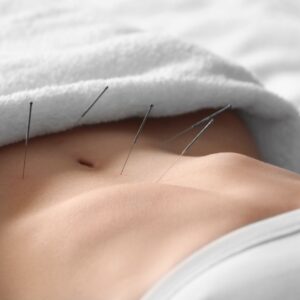
Acupuncture and Fertility
Acupuncture is a time-honoured foundation of traditional Chinese medicine. It has emerged as a celebrated modality in Western healing practices, particularly for its promising role in enhancing fertility. This ancient technique stimulates precise meridians within the body to re-establish equilibrium and promote the natural flow of energy. Scientific studies lend credence to its efficacy. They reveal that acupuncture can increase fertility rates by improving blood flow to reproductive organs, balancing hormone levels, and reducing stress. By integrating this practice, numerous individuals have reported a marked improvement in their reproductive health
This presents an exciting opportunity for individuals seeking to optimize their chances of conception. It also underscores the importance of a holistic approach to reproductive health. As we continue to unravel the mysteries of acupuncture, its place in modern fertility treatments will undoubtedly become more widely recognized. This time-honoured tradition has immense value in enhancing general health, providing optimism and viable options for those facing difficulties with conceiving.

Herbal Medicine’s Role in Conception
Throughout the ages, herbal medicine has been interwoven with our ancestors’ quest for wellness. It offers natural remedies to various conditions, including the delicate process of enhancing fertility. Research has highlighted the encouraging potential of plants like vitex, commonly called chasteberry, for their possible impact on regulating hormones and improving ovulation. Alternative Medicine practitioners believe that red clover, with its phytoestrogenic properties, offers a supportive boost to reproductive health. Furthermore, they celebrate the understated evening primrose oil, rich in omega-6 fatty acids, for promoting cervical mucus quality, thereby facilitating the ideal conditions for conception.
Aligned with empirical wisdom, modern research scrutinizes these claims, striving to quantify their efficacy with scientific rigour. While statistics and conclusive evidence are growing, they require more exploration to endorse these herbs as mainstays in reproductive support.
Amidst this hopeful narrative, a note of caution to consult with all healthcare professionals administering care before integrating herbal remedies into your daily regimen. A Traditional Chinese Medicine practitioner, like Xinling Leng, will understand how herbal remedies interact. Bring your family physician or pharmacist into the loop before committing to herbal medicines to guard against interactions with Western medication. Doing so is a fundamental step that champions safety and personalizes care. Such consultations ensure that potential interactions with present medicines or treatments are carefully considered, honouring your health’s unique tapestry. This partnership between you and your healthcare providers is paramount, underpinning a wellness journey rooted in understanding and respecting ancient remedies and contemporary medical insights.

Diet and Fertility
Our food choices are vitally important for our overall health and reproductive potential. Nourishing your body with a diet abundant in antioxidants, like vitamins E and C found in fruits and vegetables, can protect your cells from damage and support your body’s natural reproductive processes. Lean proteins, such as fish and poultry, offer essential amino acids without the added burden of saturated fats, promoting optimal hormonal balance. Healthy fats, including those from avocados and olive oil, play a crucial role in developing healthy eggs and sperm. Whole grains, rich in fibre, can help regulate blood sugar levels, which are critical for maintaining hormonal equilibrium.
Research suggests that women who follow a diet high in these components experience an increased likelihood of conception. Emerging studies illuminate the profound impact diet can have on fertility. For instance, research published in “The American Journal of Obstetrics and Gynecology” highlights that woman who followed a diet rich in healthy fats, whole grains, and plant-based proteins improved their ovulatory function. Conversely, those who consumed higher levels of trans fats, refined carbohydrates, and animal proteins experienced diminished fertility.
We understand that the path to conception is profoundly personal and sometimes challenging. By providing your body with these vital nutrients and building blocks, you’re taking a proactive step towards creating a welcoming environment for new life and taking control of your health. With a balanced and nourishing diet, you can make positive changes in your reproductive health and support the journey towards growing your family.
Remember that every person’s body is unique, so working with a healthcare professional to find the best dietary plan for your needs and goals is essential. Holistic nutritionists, such as Lindsey Shields, specialize in crafting fertility-boosting dietary plans that consider the singularity of your needs. While the nutritional insights offered here lay a solid groundwork for aspiring parents, a hands-on approach by a professional like Shields, who conducts extensive personal assessments, is indispensable.

Reducing Stress, Boosting Fertility
Stress can significantly affect your health, and this is especially true when it comes to fertility. Studies have found that reducing stress can dramatically increase women’s chances of becoming pregnant, with some research showing as much as a 30% improvement. By bringing calming practices such as meditation and yoga into your life, you can create a more peaceful, balanced state of mind and body that may lead to better fertility outcomes.
However, there are other, perhaps less familiar, ways to manage stress that can also be incredibly effective. Working with a hypnotherapist like Ashlee Bennett might open new doors on your wellness path. This type of therapy can help you discover and change deep patterns of thinking that contribute to your stress, reshaping how your mind works positively. This could be especially helpful for those dealing with anxiety related to infertility.
Similarly, consulting with psychotherapists such as Hedy Anvari allows you to engage in meaningful conversations that provide custom solutions for your mental well-being. Studies show stress and anxiety can reduce fertility. A psychotherapist will guide you through complex emotions and equip you with specialized strategies to overcome stress and anxiety. These experts support you with scientific knowledge and emotional understanding, giving you renewed optimism and strength on your journey toward becoming a parent.

Exercise and Sleep: Unsung Heroes of Reproductive Health
Understanding and nurturing our bodies through regular but gentle exercise and ensuring sufficient, restful sleep is fundamental to our health and deeply connected to fertility. Moderate, low-impact activities such as brisk walking, yoga, or swimming soothe and energize our bodies. But did you know that moderate exercise enhances blood flow, creating a nurturing environment for reproductive health. Studies suggest that women who engage in regular, moderate exercise may experience a 5-20% increase in fertility rates.
Quality sleep, often underestimated, is a pillar of our health, crucially rebooting both body and mind. During these restful hours, our bodies can repair and balance hormones pivotal to conception. Adequate sleep, defined as 7-9 uninterrupted hours per night, has been linked to a balance in the hormones governing ovulation. Getting enough quality sleep enhances the chances of a successful pregnancy.
Both moderate exercise and quality sleep are beneficial habits as they acknowledge and respect our body’s needs. They offer physiological support and a source of empowerment and control in our wellness journeys, reminding us that our daily choices are deeply interconnected with the miracle of conception.
Conclusion
Holistic fertility treatments invite us to rethink the path to pregnancy. They are a testament to the notion that conception is a dance of harmony within our bodies. Women trying to conceive may find solace and success in these natural practices.
We encourage you to open your heart and mind to holistic fertility. Whether it’s acupuncture, a diet tweak, or a new stress-reduction practice, every step toward a natural pregnancy is a stride toward hope.
—
To all the strong women on this path, remember that your story is unique, and so, too, will be your road to motherhood. Keep hope and health at the heart of your quest, and may your pregnancy dreams come to fruition.
Written by DeVera Nybo, MBA, Owner of Newleaf Total Wellness Centre

Healthy Habits & Lifestyle
In an age where health conscientiousness is a lifestyle, supplements have become as ubiquitous as gym memberships and protein shakes. But as our shelves sag under the weight of these promising bottles and packets, it’s crucial to discern the science from the marketing, ensuring that what we ingest aligns with our wellness objectives. This blog post will guide health enthusiasts, fitness fans, and wellness seekers through the complex world of natural aides and remedies.

What Are Supplements?
At their most basic, supplements are products intended to augment the diet. They can include vitamins, minerals, herbs, amino acids, enzymes, and other nutrients. They come in various forms, including tablets, capsules, powders, and liquids.
The general idea is that they can enhance your health. However, it’s important to remember that they are not intended to replace whole foods or a balanced diet but to work alongside them.
The Natural Fallacy
A common misperception about supplements is the belief that ‘natural’ necessarily equals ‘safe.’ Just because a supplement is natural does not mean it lacks side effects or risks. In many cases, ‘natural’ supplements can interact with prescription medications, may not be advisable for specific health conditions, or could even contain contaminants.
Echinacea, widely thought to prevent or treat colds, may interact with medications that affect the liver. Similarly, St. John’s Wort, while natural, can interfere with antidepressants and birth control pills. Always research and understand all the side effects and interactions a supplement might have. If in doubt, consult a Naturopathic Doctor and follow their advice strictly.

Quality Matters: Not All Supplements Are Created Equal
The supplement industry is vast and varied, and not all products adhere to the same quality standards. Some supplements may have filler ingredients, and others could have a higher or lower potency than labelled. Look for certifications or third-party testing from organizations like NSF International to ensure product quality and potency.
Seek Professional Guidance
Before adding any supplement to your regimen, consulting a regulated health professional such as a Naturopathic Doctor is imperative. They possess comprehensive knowledge about supplements, including their benefits, risks, and potential interactions with other medications.
With the explosion of supplement use, many people turn to the internet or gym acquaintances for advice. While well-meaning, such sources may lack the depth of knowledge necessary to provide safe recommendations. Professional advice is not just a formality—it’s a crucial step in safeguarding your health.

Supplements Are Not Silver Bullets
It’s vital to recognize that supplements are not a cure-all. They are not meant to replace the fundamental components of a healthy lifestyle: nutritious meals, regular physical activity, adequate sleep, and stress management. Supplements should enhance, not substitute for, these pillars of health.
Investing in quality whole foods, learning to prepare balanced meals, and maintaining a stable exercise routine are foundational. Supplements can fill nutritional gaps or assist with specific deficiencies, but one should not lean on them as crutches that allow neglect of diet or exercise.
Conclusion
Supplements might play a role in your health strategy, whether you’re looking to optimize your physical performance, enhance your well-being, or address specific health goals. Nonetheless, it’s crucial to approach them with a discerning eye, armed with information and professional guidance.
Remember that the pursuit of health is a holistic endeavour. When supplements find their appropriate place within a balanced lifestyle, they can be beneficial allies on your wellness journey. Always prioritize the natural abundance of nutrients available through a diverse diet and use supplements wisely to augment your path to health.

Remember:
- Verify the safety and quality of any supplement you consider taking.
- Consult with a healthcare provider before starting any new supplement, especially if taking other medications.
- Do not rely on supplements to replace a nutritious diet and active lifestyle.
Stay informed, stay healthy, and stay dedicated to your wellness goals. If you have questions about interactions, consider booking an appointment with a Naturopath. If you want to know more about how supplements can help you achieve your nutrition goals, consider booking a consultation with a Holistic Nutritionist.
Written By: DeVera Nybo, MBA, Owner Newleaf Total Wellness Centre

Injury Rehab and Prevention
In pursuing physical fitness and health, we often focus on the number of reps, the weight lifted, or the miles run. But there’s an essential element that you should never overlook – good form. Proper form is the linchpin of efficient and productive workouts. It can make the difference between spectacular results and stagnation or, even worse, injury.

Why Good Form Matters
Injury Prevention – When you exercise ensure that you maintain a neutral spine, engage the core, and use controlled movements throughout the exercise. Proper form reduces undue stress on your muscles, joints, and ligaments. Poor form can lead to strains, sprains, or more severe injuries that significantly setback your fitness goals.
Maximized Efficiency – Good form allows you to target the intended muscle groups effectively. It ensures that each movement is as impactful as possible, leading to better muscle growth and strength development.
Enhanced Endurance and Strength – The correct posture usually requires engaging your core and other stabilizing muscles, contributing to improved overall endurance and functional strength. This means looking better and performing better in daily activities and sports.
Steady Progression – Proper technique makes you likelier to progress consistently in your workouts without hitting plateaus caused by injuries or incorrect muscle usage.

Tips for Maintaining Good Form
Educate Yourself – Understand each exercise’s mechanics and purpose – this could involve working with a trainer, watching instructional videos, or reading fitness articles and books.
Use Mirrors – Watch yourself when you perform an exercise. A side view can be particularly enlightening when checking your form.
Go Slow. Master the technique by performing the exercises slowly at first. Once you’re confident you’ve mastered it, you can increase your speed or introduce more complex movements.
Stay Focused – Your form can slip when the mind wanders. Stay focused on your movements and the muscle groups you’re working out.
Don’t Overload – Lifting too much weight or pushing too hard can quickly lead to a breakdown in your form. Start with lighter weights and build up gradually.
Seek Feedback – Regularly check in with a trainer or knowledgeable workout buddy to monitor you and correct deviations.

The Bottom Line
Good form is more than looking good at the gym; it’s about treating your body respectfully and working out to promote optimal health and performance.
Remember that quality always trumps quantity in the journey towards better health and fitness. Take a moment to assess your workout routine and adjust your form where necessary. Your body and your future self will thank you.

Call to Action
Are you ready to refine your workout for better results? Remember, the key to successful workouts is not just being active; it’s being mindful about your activity.
Stay strong and work out smart!
—
On your path to better fitness, always consult a professional trainer or healthcare provider to ensure the exercises and workout plans are appropriate for your unique health and fitness goals.

Conditions We Treat
Sciatica! It sends shivers down your spine quite literally. If you’re wincing from pain that shoots through your lower back down to your legs, you may be one of many grappling with this common culprit of agony. But what exactly is sciatica, and how can you alleviate the pain and prevent it from hijacking your life?
What is Sciatica?
First, it is important to note that sciatica is not a standalone condition or diagnosis. Sciatica describes the symphony of symptoms stemming from the compression or irritation of the sciatic nerve. The cause of this compression or irritation is the underlying reason for your pain and defines the type of treatment you will need to feel better.
The sciatic nerve begins in your lower spine and travels through your buttocks down to your feet. It is the body’s longest and largest nerve, and when it’s injured or irritated, it does not whisper – it roars. The specific characteristics of sciatica include a pain that originates in the back or buttocks and travels down the leg. Sufferers typically report pain on one side of the body which may worsen with sitting, coughing, or sneezing. The pain, often depicted as a sharp or burning sensation, might be accompanied by tingling, pins and needles, numbness, muscle weakness and even incontinence! The symptoms are as diverse as its potential causes, which range from bulging disks to the physical strain of pregnancy.

What Makes Sciatica Worse?
Numerous factors can exacerbate sciatica, including obesity, an inactive lifestyle, smoking, and sleeping on a mattress that is too soft or too firm. Risk factors like age, twisting your back or lifting heavy loads at work, and even diabetes, can intensify your discomfort.
What Can Bring Relief?
Heat and ice therapy, over-the-counter medications, and proper posture are accessible first steps in managing the pain. Additionally, physical activity and maintaining a healthy weight can lead to significant improvements. Embedding core strengthening exercises into your daily routine can also provide relief. Strong core muscles take the pressure off your spine and can reduce the risk of many of the types of injury that cause sciatica.

Treatment Options for Sciatica
For most, the agony can wane without surgical intervention. Conservative treatments include physical therapy and medications, while epidural steroid injections offer a more intermediate solution. You may consider surgery if all else fails or if your quality of life severely declines.
It’s crucial to remember that the path to improvement isn’t one-size-fits-all. Exercise therapy, chiropractic adjustments, yoga, acupuncture, and massage therapy offer a unique way to engage the body’s innate healing processes. These conservative treatments are key players in the management of sciatica, striving to provide both immediate comfort and long-term relief.
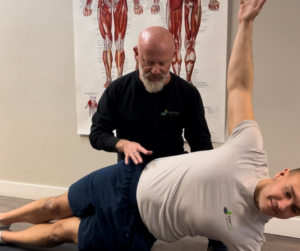
Your Role in Sciatic Nerve Pain Management
Complications from sciatica, such as ongoing pain or muscle weakness, can indeed cast long shadows over one’s quality of life. Avoiding these dark outcomes means investing time into prevention. Maintaining good posture, staying active, and allowing for recovery when back pain first whispers its warning signs will help minimize sciatic nerve pain.
Engage in regular exercise to activate and engage the core muscles supporting your spine, and practice good posture to relieve pressure on your lower back. If you spend hours sitting, change positions often and, if necessary, take breaks to move around. Adopt a holistic approach to health, with sufficient rest periods to speed recovery when needed.
Avoid tobacco products, ensure you’re lifting objects with correct form to avoid strain, and equip yourself with knowledge. The more informed you are about your condition, the more empowered you are to make decisions that benefit your health.
Conclusion
Navigating the waters of sciatica involves understanding the condition, recognizing risk factors, engaging in preventative efforts, and exploring a spectrum of treatments. Remember, while the pain might be profound and sometimes lead to complications, most people recover within a few weeks.
For persistent or severe pain, especially if accompanied by additional symptoms such as muscle weakness or loss of bowel or bladder control, seeking medical care is imperative. With the right advice and action, you’re on your way to reclaiming comfort and command of your well-being.
Your Health is Your Wealth
Remember, your pursuit of relief is not a solitary expedition. Please, if you are burdened by the weight of sciatic discomfort, reach out to one of our physiotherapists today and book an initial assessment.
Written By: DeVera Nybo, MBA, Owner Newleaf Total Wellness Centre.

Healthy Habits & Lifestyle
Discover Your Body’s Vibrant City: The Gut Microbiome
Think of your body as a city teeming with life. Your body houses trillions of tiny inhabitants that play a massive role in how you think, feel, and fight off sickness. We’re talking about your gut microbiome. It’s like the unsung hero inside you, bustling and brimming with activity that affects every beep and blip in your body’s systems.
Why Your Microbiome Holds the Key to Health
You have trillions of microscopic allies working tirelessly for your holistic health. This is the reality of your gut microbiome. Like the most caring guardians, they oversee critical aspects of your physical and mental well-being.

Understanding the Gut-Brain Axis
Have you ever wondered why you feel butterflies in your tummy before a big event? Or why a not-so-happy belly can ruin your mood? Prepare to be amazed because it all boils down to the magic between our gut and brain. The gut-brain connection, or the gut-brain axis, is a complex two-way communication system involving nerves and biochemicals between the digestive tract and the brain.
Key aspects of this connection include:
- Neural Pathways: Your central nervous system interacts with the enteric nervous system in the gut, mainly through the vagus nerve.
- Neurotransmitters: The gut manufactures crucial neurotransmitters like serotonin, which affects mood, appetite and sleep.
- Immune System: Gut immune cells communicate with the brain, impacting mood and behaviour.
- Microbiota: The diverse organisms in the gut can produce substances that influence neurological function.
Meet Your Inner Metropolis
Your gut microbiome isn’t just hanging out; it’s like a superorganism always chatting with your brain. Picture an intricate dance of signals and messages tying your gut and brain together in constant conversation.
The Gut-Brain Superhighway
This two-way street means that your gut doesn’t just listen – it talks back, influencing your mood and well-being. It’s a remarkable communication network that ties your emotions to your immunity, your stress to your stomach, and your dietary choices to your mental health.
Impacting Your Health in Every Way
Imagine the power this gives you over your health. Knowing this, you hold the key to unlocking better mental health, a stronger immune system, and an overall sense of harmony within – simply by understanding and caring for your gut.

Practical Tips for Microbiome Improvement
Loving your gut isn’t only about eating your greens or cutting out sugar (though that is important, too!). It’s also about fine-tuning hours.
Yes, you read that right – Hours of sleep, activity, stress levels, and even social interactions affect the balance of good bacteria in your gut. And with a healthy microbiome comes a happy mind!
The Balance Disruptors
Unfortunately, modern lifestyles may be waging war on our body’s microbiome. Here are the culprits that could be throwing your gut-brain axis off balance:
- Dietary Choices: Our fast-food culture often lacks the nutrients necessary to support a healthy microbiome.
- Antibiotic Use: While lifesaving, antibiotics can decimate beneficial and harmful gut bacteria.
- Stress: It’s not just a mental burden; stress can stunt the growth of good bacteria.
- Harsh Cleaning Products: They might keep our homes spotless, but they can also disrupt the delicate balance of our internal ecosystems.
- Environmental Factors: Pollution and other contaminants can have unseen effects on gut health.
- Certain Medications: Apart from antibiotics, other drugs can also alter the microbial landscape in our guts.
Paving the Path to Optimal Gut Health
Fear not; you can do much to nourish and support your gut microbes. Here’s how to optimize your gut bacteria for better health:
- Prebiotics (Fiber): These are the foods that your gut bacteria feast on. Think of high-fiber plants like bananas, onions, and oats.
- Probiotics: Often found in fermented foods like yogurt and sauerkraut, these foods help introduce friendly bacteria to your digestive system.
- Exercise: Studies show that regular physical activity enriches our gut flora diversity.
- Dietary Choices – Again!: A varied diet rich in whole foods supports a healthy microbiome.
- Natural Cleaning Products: Opting for gentler home and body cleaning products can keep your microbes merry.

Conclusion
The adage “trust your gut” gains new meaning when we consider how intimately it’s linked to our overall health. Through thoughtful daily choices in diet, exercise, and stress management, we bolster our guardians within. Take heart, knowing that with every fiber-rich bite and every mindful breath, you’re contributing to the vast community inside you that works around the clock to ensure your optimal health.
Care for your microbiome, and it will care for you -ushering you along a path filled with energy, balance, and joy. Start today. Embrace these simple yet profound steps towards an enriched life because a healthy gut means a happier you.
Remember, when your gut brims with life, so do you. Protect this precious treasure, and the rewards for your mind, body, and spirit will be immeasurable. To learn more, book a free consultation (15 minute meet and greet) with Lindsey Shields, a Holistic Nutritionist.
Written By: DeVera Nybo, MBA – Owner Newleaf Total Wellness Centre

Chronic Conditions & Holistic Health
Migraine sufferers know the drill all too well – pounding headache, sensitivity to light, and the overwhelming desire to retreat to a dark, quiet room. But what if there were a gentle, non-invasive therapy poised to complement your pain management routine? Enter Cranial Sacral Therapy (CST) – a subtle yet powerful treatment with promising results for those plagued by this disabling condition.
How Does Cranial Sacral Therapy Work?
Cranial Sacral Therapy (CST) is a holistic healing practice that uses light-touch, non-invasive techniques to support the harmony of your body’s natural rhythms. The logic behind CST is fascinating. The therapy focuses on reducing compression in key body structures, bringing a sense of release that can often seem immediate. Imagine the relief as the built-up stress and pain caused by your migraines begin to melt away under the expert touch of your therapist, like ice surrendering to the warmth of the sun.
Data is key. Though anecdotal testimonies support the effectiveness of CST, scientific studies are contributing to a growing body of evidence on its benefits. For instance, a clinical trial assessing CST for migraine treatment has revealed a remarkable safety profile and strong indications of efficacy, renewing hope for headache-specific quality-of-life improvement without the side effects common to pharmaceutical interventions.

What Happens During a Cranial Sacral Therapy Session?
Our trained professionals engage in gentle manipulations, listening to your body’s subtle rhythms. With each motion, your practitioner works to normalize the flow of cerebrospinal fluid, aiming to enhance your body’s natural healing capabilities. Understanding what occurs during a CST session can help set the stage for a tranquil and potentially transformational experience.
Check-In at Reception
When you book a session for cranial sacral therapy, peace of mind begins the moment you step into our serene environment. Your session starts when you arrive, and calm, professional staff greet you. Here, you can unwind from the outside world and shift your focus inward to your healing experience.
Transition to the Treatment Room
You’ll be led to a treatment room with soft lighting and a serene environment designed to trigger relaxation. This tranquil space will serve as your healing sanctuary, where the bustle of everyday life starts to dissipate. Focused on achieving ‘Stronger, Braver, and Better’ outcomes, our practitioners stand ready to restore balance within your body.
The Treatment Room
You’ll stay fully clothed during the session, so it’s best to wear loose, comfortable clothing. This allows you to lie down on the treatment table without restriction, giving a deeper sense of relaxation.
Typically, you’ll lie on your back on a softly padded treatment table, poised to begin the therapeutic process. The therapist ensures you are comfortable, perhaps providing additional support with pillows or blankets if necessary.

Cranial Sacral Therapy: Gentle ‘Listening’ Through Touch
The heart of a Cranial Sacral Therapy session is when the practitioner lightly places their hands upon you. They may start at your head, neck, or back, ‘listening’ to your body’s rhythms and searching for disruptions in your craniosacral rhythm. This form of palpation and intuition guides the session and is followed by gentle movements to balance the flow of cerebrospinal fluids.
Clients often report sensations of deep relaxation and tranquility during their CST sessions, akin to the calm after a storm. Stress, a known trigger for migraines, dissipates, paving the way for better sleep, improved mood, and enhanced overall well-being.
Duration of the Session
Most CST sessions last around 45 minutes, though the clinic can adjust this duration based on the practitioner’s recommendations and your individual needs.
The Healing Experience of Cranial Sacral Therapy
As the therapist’s gentle touch guides the session, many people report deep relaxation akin to meditative tranquility. Muscle tension loosens, pain decreases, and you may become acutely aware of bodily sensations, ranging from warmth and tingling to a rhythmic pulsing.
The CST protocol honours the body’s thresholds. The practitioner ensures each session is calibrated to individual needs. While side effects are rare, they take the utmost care, particularly with those with contraindications such as bleeding disorders or recent traumatic injuries.

Potential Emotional Release
It’s not unusual to have an emotional response during or after Craniosacral Therapy. You might experience a spectrum of feelings – such as relief, joy, or an unexplained sense of grief – as the treatment releases emotional blockages, allowing for cathartic healing.
The Subtle After-effects of Cranial Sacral Therapy
At the end of your Cranial Sacral Therapy session, you may feel light and balanced, having started a process of healing that resonates at the very core of your being. Sometimes, you may not feel the effects at once. In these cases, the body often subtly and gradually processes the therapeutic intervention. Changes can unfold in the hours or days following a session.
Conclusion
Whether you’re looking to alleviate migraines, reduce stress, or explore the profound layers of holistic therapy, a Craniosacral Therapy session could be a calming and curative experience. Remember, each person’s body responds uniquely to CST, and it may take multiple sessions to feel the full benefits.
The key to CST is openness. Everyone’s experience is individual, and the path of healing is as personal as the rhythm in your craniosacral system.
If you are ready to try this gentle, non-invasive form of bodywork, book a free consultation with Gagandeep Watts and take the first step to physical and emotional harmony through Cranial Sacral Therapy.
Written by: DeVera Nybo, MBA, Owner of Newleaf Total Wellness Centre
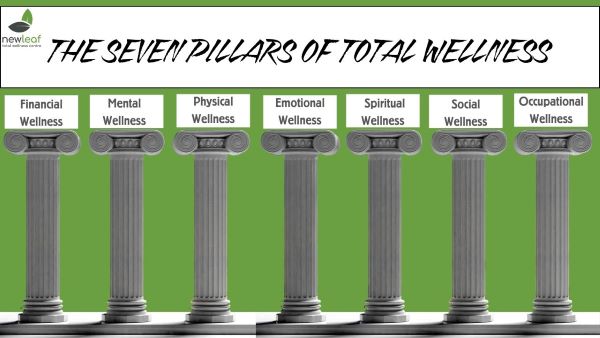
Healthy Habits & Lifestyle
The Seven Pillars of Total Wellness: A Holistic Approach to Your Well-Being
In the bustling rhythm of modern life, we often focus on one aspect of health while neglecting others. Wellness is frequently mentioned in passing as if it’s a state we stumble upon rather than something we can cultivate. Yet, total wellness requires a holistic approach that intertwines various facets of our existence. Today, we explore the Seven Pillars of Total Wellness—a framework that empowers you to attain harmony and vitality in every part of your life.
Understanding and nurturing each pillar is critical to a balanced lifestyle that radiates positivity, productivity, and peace. If you’re committed to thriving, not just surviving, join us in this enlightening exploration toward total wellness. And remember, if you need support in building these pillars in your life, Newleaf Total Wellness Centre is here with a team of over 20 therapists across 13 disciplines, ready to guide you to your personalized version of complete health and satisfaction.

Financial Wellness: The Foundation of Stability 💰
Financial health isn’t about amassing wealth but finding balance in your financial life that brings peace of mind and security. It’s about creating a budget that reflects your values, saving for emergencies, investing wisely, and planning for retirement. A balanced budget allows you the freedom to enjoy life without monetary stress or worry. Financial strain can tremendously impact other aspects of well-being, so being prudent with your resources is vital.
- Budgeting: Start by tracking your spending and setting realistic budgets.
- Saving: Aim to build an emergency fund that covers several months of expenses.
- Investing: Educate yourself on investment options and seek advice when necessary.

Mental Wellness: The Cradle of Creativity 🧠
Elevate your intellectual health by nurturing your mind. Challenges keep your brain sharp, so never shy away from learning new skills, reading broadly, or engaging in thought-provoking conversations. Your mental pillar is vital; it supports your creativity, decision-making, and lifelong pursuit of learning. The intellect’s flexibility forms your resilience against life’s unending changes.
Mental well-being is linked to the overall condition of a person’s mental state, which encompasses logical thought processes, sound judgment, and the ability to handle challenging circumstances. It relates to how we think, learn, and grow intellectually. A positive mindset enhances our clarity, decision-making, and productivity.
- Continuous Learning: Engage in activities that challenge your intellect, such as reading, solving puzzles, taking a course, or learning a new skill.
- Positive Thinking: Practice mindfulness and gratitude to cultivate a positive mindset.
- Seek Professional Help: Mental health issues may lead individuals to act out or engage in risky activities. Medical interventions, including counselling and medication, may be necessary to regain mental health.

Physical Wellness: The Essence of Energy 💪
Physical fitness is the force that fuels your wellness structure. Our bodies are our temples, and how we treat them can significantly impact our overall well-being. Physical wellness is maintaining a healthy body through regular exercise, proper nutrition, and adequate sleep. This pillar is more than achieving peak performance or sculpting an ideal physique. A physically healthy person is more robust, energetic, and equipped to handle life’s challenges.
- Nutrition: Eat a balanced diet rich in whole foods, lean proteins, and fresh produce.
- Exercise: You don’t have to spend hours in the gym. Get outside. Go for a walk. Take the stairs or park further from the entrance.
- Seek Professional Help: Use your workplace health insurance plan to see a physiotherapist, kinesiologist or athletic therapist for a functional movement assessment and exercise prescription to help you meet your goals.

Emotional Wellness: The Heart of Connection ❤️
The emotional wellness pillar asks for self-compassion and deep, meaningful relationships. It involves understanding your feelings, expressing emotions in healthy ways, and developing empathy towards others. Emotional health allows us to cope with life’s stressors, build and maintain relationships, and recover from emotional setbacks.
Emotional well-being involves the capacity to control and balance various emotional states. This includes effectively managing reactions to stress, anger, sorrow, and happiness to maintain healthy relationships. When it comes to emotional wellness, an individual’s actions are often more influenced by their emotional state rather than a definitive mental illness. Struggling to regulate one’s feelings is frequently a telltale symptom of emotional turmoil.
- Relationship-Building: Nurture your emotional connections with open communication and empathy.
- Identify Triggers: Get help to understand, name, and control your emotional triggers. This can help you lead a happier and healthier life.
- Self-Care: Take time to engage in activities that soothe and rejuvenate you emotionally.

Spiritual Wellness: The Search for Meaning 🙏
Spiritual wellness can mean different things to different people. For some, it might be a traditional religious practice; for others, it could mean a personal connection to nature or the arts. This pillar involves finding meaning and purpose in life, which imparts a sense of fulfillment and can help steer one through rough waters. It empowers you to align actions with your innermost values, leading to a life infused with intention.
- Purpose: Volunteer for causes you believe in to connect with your sense of purpose.
- Reflection: Allocate time for meditation, prayer, or quiet contemplation.
- Define Your Values: Understanding your values sends a clear message about who you are, what you believe in, and what you stand for. It’s a compass to guide your decisions and actions.

Social Wellness: The Hub of Harmony 🤝
Humans are social beings, and our relationships can profoundly impact our overall well-being. Social wellness is the pillar that encourages building healthy, nurturing, supportive relationships and fostering genuine connections with those around you. Finding community and a sense of belonging contribute to social wellness. It’s not about the number of friends or followers – it’s the quality of connections that count. The sense of belonging, rather than fitting in, and our contributions to society fortify this crucial component of our well-being.
- Community Engagement: Participate in community events, clubs, or online forums to meet like-minded individuals.
- Support System: Cultivate relationships that provide mutual support and growth.
- Be Yourself: Differentiate between belonging and fitting in. Fitting in forces us to squash parts of ourselves to be like everyone else in the group. Belonging demands we be ourselves with others.

Occupational Wellness: The Pursuit of Career Satisfaction 💼
Lastly, the occupational pillar is about finding gratification and fulfillment in your work. Look for a career that allows you to contribute your unique talents and passions while providing a sense of accomplishment and meaning. This pillar is a testament to the fulfillment of contributing your unique skills to a greater calling.
- Work-Life Balance: Establish clear boundaries between work and personal time.
- Career Growth: Set career goals and seek opportunities for professional development.
- Alignment: Choose work that aligns with your values and skills to give you a sense of balance, pride and accomplishment.
In Summary
Each pillar of total wellness is indispensable, and nurturing all of them leads to a more balanced, joyful, and fulfilling life. From financial security to spiritual depth, every aspect contributes to a healthier, happier you. Balancing these seven pillars will not happen overnight. It requires introspection, commitment, and sometimes change, which can be challenging but also rewarding.
Remember, you do not need to take this wellness journey alone. If you need assistance strengthening any of these pillars, Newleaf Total Wellness Centre is your ally. With our diverse range of therapies and skilled professionals, we can help you achieve your version of total wellness. Please contact us, and together, we’ll make sure to build the pillars that uphold the radiant temple of your well-being.
Your best life is waiting. Step forward, reach out, and seize it with both hands.
Written By: DeVera Nybo, MBA, Owner of Newleaf Total Wellness Centre

Mental Health and Emotional Wellness
Are you trying to push past the pain hidden in the shadows of your past trauma or current stress? Are you also struggling with physical pain? At Newleaf Total Wellness Centre, we understand that emotional turmoil doesn’t just leave scars on your mind; it entrenches itself deeply within your body. Psychological pain and physical pain often go hand-in-hand. In fact, up to 90% of women with fibromyalgia and a significant portion of arthritis patients report trauma at some stage in their lives ([How is Psychological Trauma Linked to Chronic Pain? – Pathways]).
This blog post is a must-read for everyone, from mental health advocates and holistic health seekers to PTSD survivors and those grappling with the ongoing challenge of daily stress.
A Journey Through the Body’s Emotional Landscape
Our bodies are living libraries of every experience we’ve endured. From the pain of a violent childhood to the sting of discrimination, emotions carve their histories into our muscular fibers and nervous system. Trapped emotions can lead to feelings of resentment, poor decision-making, and even physical illness. Our body remembers and holds onto these moments, manifesting as chronic stress, anxiety, and depression ([How to Release “Emotional Baggage” and the Tension That Goes With It]).

The Echo of Release: An Emotional Catharsis
Have you ever walked out of a physiotherapy, chiropractic or acupuncture appointment with tears streaming down your face, and thought, “Wait a minute, I didn’t even feel a pinch!” We get it. Those tears aren’t from pain – they’re pathways to release pent-up emotions.
Your tears are a testament to the mind-body connection. They are a revelation that within every point on the body lies a locked door to emotional release. Once opened, they can usher in new beginnings and brighter days.
The Holistic Approach to Emotional Release
At Newleaf, we offer an assortment of treatments, including manual osteopathy, visceral manipulation, cranial sacral therapy, acupuncture, trigger point release, and myofascial release. These treatments help synchronize your emotional and physical well-being. Our therapists are experts in various techniques and compassionate guides who walk with you through the terrains of emotional wellness.

The Power of Manual Therapies in Emotional Healing
When you’re pushing through the hustle and bustle of life, emotions tend to take a back seat. But with the gentle touch of a skilled therapist, these emotions find a way to the surface. Crying during or after treatment is more than okay—it’s a healing sign. Remember, the physical and emotional are intertwined. Just like two harmonious notes in a soothing melody, they work better together. And that emotional outpouring is harmony in the making.
Our treatments may coax out the shadow of emotions hidden deep within your tissues, liberating them, and allowing your body to reclaim the joy of living free from the chains of past traumas.
In the grand scheme of things, your surprising post-treatment tears are GOOD NEWS. They herald the coming of balance, the approaching of better health, and the promise of well-being.

Counselling: Healing Beyond the Surface
Imagine a world where your journey to healing is not just about mending the visible wounds but a path that delves deep into the recesses of your mind and spirit. Welcome to a space where counselling meets holistic care, transforming lives beyond the surface.
We believe that true wellness blossoms from a blend of physical and mental care. Our comprehensive approach to health transcends traditional practices, venturing into the vast landscape of the human psyche. Here, we hear every story, acknowledge every emotion, and empower every individual.
We are your allies in the odyssey of self-discovery and recovery. You may choose between psychotherapy’s insightful exploration, hypnotherapy’s profound subconscious journeys, or transformational life coaching’s empowering strides, or sample them all. At Newleaf Total Wellness Centre, we cater to every need.
The Guiding Light of Accredited Knowledge
Our treatments are informed by knowledge and skill recognized and regulated for your safety and trust. The Canadian Counselling & Psychotherapy Association (CCPA), The College of Physical Therapists of BC (CPTBC), The College of Traditional Chinese Medicine & Acupuncture (CTCMA) and the College of Registered Manual Osteopaths stand as beacons in their respective fields, ensuring professional care that resonates with the rhythm of healing.

Begin Your Healing Odyssey
It’s time to unburden yourself from the weight of trapped emotions. It’s time to realize that your tears are markers of progress on a quest to rediscover balance and vitality. Check out the services offered at Newleaf Total Wellness Centre and forge a path of healing that harmonizes body, mind, and spirit. We’re not just treating symptoms. We’re nurturing wholesome, enduring wellness for a Stronger, Braver, Better you.
Remember, every step, treatment, and release are a movement towards an emotionally resilient you. Reclaim the wellness that awaits at Newleaf Total Wellness Centre.
Embrace the holistic way. Nurture your wellness. Unleash your potential.
Written By: DeVera Nybo, MBA, Owner Newleaf Total Wellness Centre

Real Patient Success Stories
When it comes to receiving a massage, the experience should be therapeutic and rejuvenating. Massage therapy is a harmonious blend of professional care and personal comfort. At Newleaf Total Wellness Centre, your well-being is our priority. There are several things our Registered Massage Therapists (RMTs) wish for you to know to elevate your treatment experience with us.
Arriving Prepared: Small Steps for Punctuality and Consideration

1. Use the Restroom Before Your Massage
Take a moment to use the washroom. It’s a small yet significant step in ensuring we can dedicate your entire appointment time to your massage. Don’t hesitate to ask our friendly administrative staff for directions. By addressing biological needs beforehand, we can devote every minute of your appointment to the healing touch of massage therapy.
2. Punctuality is Part of Self-care
Each tick of the clock plays a vital part in the symphony of daily life. We understand that unexpected delays occur, but arriving on time for your massage shows a mutual respect for both your time and ours. We appreciate your promptness, as it directly correlates to the quality and length of your treatment, ensuring we do not miss a single note in the melody of your wellness routine.

3. Advance Notice for Massage Cancellations
We value your time as much as we do our own. Should the need to cancel arise, we request advanced notice. Our waiting list is overflowing with patients eager to step into a time slot for relief and restoration. Late cancellations or missed appointments may incur fees, but more importantly, they prevent others from receiving the care they need. Your understanding and respect in this regard are of utmost importance.
Communication: The Bridge to Exemplary Care
4. Comfort, Warmth, Ambiance – Massage Therapy Tailored to You
We are here for you to guide you to a state of holistic balance and well-being. We make every effort to craft each element of your visit to your comfort. Whether it’s the softness of the linens, the snug warmth of the room, or the gentle ambiance set by our choice of music – your preferences take center stage. Please communicate with us if anything does not meet your expectations, from temperature to volume. Our practice thrives on personalizing your massage experience.
5. Pressure Points: The Scale of Relief
The depth of pressure applied during your massage should be a therapeutic dance between effectiveness and comfort. We tune in to the symphony of the body’s needs, adapting our touch to reach the crescendo of relief. Yet, every individual is a unique tune. Whether we need to dial the pressure down to a soothing pianissimo or intensify it to a powerful forte, your feedback is the score we follow. You lead, and we listen – this is our partnership on your path to wellness.

A Personal Note
Every individual is a mosaic of preferences and needs. What may be a serene, cooling environment to one might be less comfortable to another who finds warmth healing. Our mission at Newleaf Total Wellness is to create an atmosphere that meets your comfort ideal. Our RMTs, cannot predict your preferences, but they vow to adapt to them with fluid grace.
Conclusion: Our Commitment to Your Wellness Journey Through Massage Therapy
In sharing these pieces of advice, we reiterate our commitment to your holistic health. We see you not just as patients but as partners in wellness. With open arms, we invite you to settle into our care, voice your preferences and enjoy the transformation our therapies aim to deliver.
We look forward to welcoming you into an oasis of care at Newleaf Total Wellness Centre – where each treatment is more than a service; it is a stepping stone to better health.
Remember, effective communication with your RMT is paramount. Never shy away from sharing how we can enhance your experience. Your comfort, well-being, and satisfaction are at the heart of what we do.
Ready to experience the pinnacle of therapeutic massage? Book your appointment today and feel the difference genuinely personalized care can make in your wellness journey.

Conditions We Treat
Navigating the Chill of a Frozen Shoulder – A Personal Journey to Thawing and Recovery
Frozen shoulder – the term itself may suggest images of arctic calm and stillness. But if you have this condition, you’ll quickly discover the metaphor extends far beyond the peaceful imagery and into a realm of stiffness, discomfort, and an unmistakable freeze on your daily activities.
Living with a frozen shoulder can be an excruciating and disabling experience. This painful condition limits your arm’s range of motion, causing daily activities to become challenging. I understand frozen shoulder intimately, not just as a concept but as a personal battle. If you feel the icy grip of a frozen shoulder, I come bearing warm tidings from my experience. It is possible to melt away the limitations with the right approach.

Understanding Frozen Shoulder
Frozen shoulder (adhesive capsulitis) is a condition marked by pain, stiffness, and limited range of motion in your shoulder. Symptoms usually begin gradually and worsen over time before a slow thaw begins. If left untreated, the natural recovery might take as long as a glacial two or three years.
The Comprehensive View of Frozen Shoulder article published by PMC explains the complexity of this syndrome, pointing to factors such as systemic inflammation and metabolic imbalances that may contribute to its onset. Additionally, immobility following an injury, conditions like diabetes or thyroid disorders, or even chronic stress are all potential causes. However, no one really knows what causes frozen shoulder.
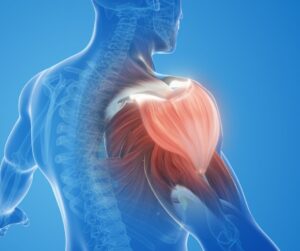
The Stages of Frozen Shoulder
It typically progresses through three distinct stages, each with its symptoms and challenges. Understanding the stages of frozen shoulder can help you better manage your condition and work towards recovery.
Stage 1: Freezing
During this stage, you may notice severe pain and stiffness in your shoulder that gradually worsens over time. During this stage, any shoulder movement can cause discomfort, with the pain often worsening at night. The range of motion in your shoulder will become more limited, making it difficult to perform everyday tasks such as reaching overhead or behind your back. The pain is typically dull or aching at rest but sharp with movement. It’s important for individuals experiencing these symptoms to seek medical advice, as early intervention can help manage the pain and potentially reduce the duration of this stage. This stage can last anywhere from 6 weeks to 9 months and is characterized by inflammation and thickening of the capsule surrounding the shoulder joint.
Stage 2: Frozen
During the frozen stage, the pain may begin to diminish. Still, the shoulder becomes stiffer, leading to a significant decrease in mobility. The reduction in pain is a somewhat deceptive sign of improvement, as the stiffness remains a substantial barrier to regular activity and function. In this phase, the shoulder may be so stiff that everyday tasks, like dressing, become difficult, if not impossible. It’s crucial to continue with therapy during this time as the focus shifts towards improving the range of motion. Patience and persistence are key, as progress can be slow but is vital for recovery. This stage can last from four to twelve months.
Stage 3: Thawing
The final phase of frozen shoulder is known as the thawing stage, where the stiffness gradually decreases and movement improves. During this period, individuals may notice a slow but steady increase in their range of motion. The pain subsides significantly, allowing for more intensive physical therapy and exercise to regain shoulder function. Staying committed to your rehabilitation plan is essential, as consistency is crucial for full recovery. Despite the challenges faced in the earlier stages, most people return to their normal activities and regain close to, if not complete, shoulder function by the end of the thawing stage, which can last from six months to two years.
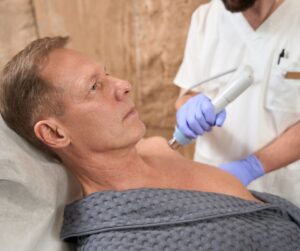
The Healing Ensemble for Frozen Shoulder
My salvation from this frigid condition arose through the collective expertise of a carefully chosen team. I had a physiotherapist, a chiropractor, a Registered Massage Therapist (RMT), and an acupuncturist working together.
Interestingly, the BC Chiropractic Association suggests core stability plays a fundamental role in injury recovery, including for frozen shoulder. Meanwhile, several studies highlight the role of nutrition in managing inflammation and aiding in hormonal balance. So, adding a kinesiologist, athletic therapist, and holistic nutritionist to your team may also be a good idea.
Physiotherapy for Mobility
With their sophisticated grasp of movement and mechanics, physiotherapists play a crucial role in helping patients with frozen shoulder regain function and reduce pain. Through mobility and strengthening exercises, intramuscular stimulation/ dry needling, manual therapy techniques, and education, physiotherapists can support individuals on their journey towards improved mobility and quality of life. They use techniques like myofascial release, gentle dynamic movement, and joint mobilization. Furthermore, physiotherapy for frozen shoulder often includes modalities such as heat therapy, ultrasound, shockwave, or electrical stimulation to help reduce pain and inflammation in the affected area. These modalities can provide temporary relief from symptoms while working alongside other treatments.

Chiropractic to the Rescue
Chiropractors focus on manipulating the body’s joints to induce healing and improve mobility, all while decreasing pain. Their informed techniques work on restoring joint mobility and treating the surrounding architecture, emphasizing a holistic recovery. These techniques often include mobilization and manipulation of the shoulder joint and the joints in the neck and upper back, which can also become stiff and tight when dealing with a frozen shoulder. Chiropractors use muscle release techniques to help restore proper mobility of the shoulder and surrounding tissue. At the same time, corrective exercises help maintain the range of motion and increase strength and stability within the shoulder. With its focus on improving joint function, reducing inflammation, creating personalized treatment plans, and promoting overall wellness, chiropractic care offers a comprehensive approach to alleviating frozen shoulder symptoms and restoring optimal function in your shoulders.

The Gentle Touch of Massage Therapy
The path to healing benefits significantly from the relaxing yet deep-reaching techniques a registered massage therapist applies. Their trained hands work wonders, encouraging tight muscles to release their grip and become more flexible. In addition to loosening tight muscles and improving circulation, massage therapy can help reduce stress and promote relaxation.
Chronic pain and limited mobility can take a toll on both physical and mental well-being, leading to increased stress levels. Massage therapy provides a safe space for patients to relax, unwind, and release physical and psychological tension. Furthermore, regular massage therapy sessions can help prevent future flare-ups of frozen shoulder by maintaining muscle flexibility and promoting overall joint health.

Acupuncture: Ancient Art of Precision
I found this modality indispensable in lessening the throbbing ache. With each targeted insertion, my shoulders experienced minor releases, combining into a cascade of greater movement and relief. Studies show that acupuncture triggers the release of endorphins, which are the body’s natural painkillers. This helps to reduce discomfort associated with frozen shoulder. Additionally, acupuncture can help improve the range of motion in the shoulder joint by promoting relaxation in tight muscles and enhancing blood flow to the area. By targeting key points related to the shoulder joint and surrounding muscles, acupuncture can help reduce pain, increase mobility, and promote healing naturally.
A Resource You Can Count On
At Newleaf Total Wellness Centre, we understand that recovering from frozen shoulder requires a multi-faceted approach. That’s why our team consists of various healthcare professionals who specialize in different areas. With a combination of hands-on therapy from a physiotherapist and RMT and alternative treatments like acupuncture and holistic nutrition, we have it all under one roof.
One of the key benefits of working with Newleaf Total Wellness Centre is the convenience of meeting all your healthcare needs in one place. Instead of running to different clinics for various treatments, you can trust our team to coordinate your care and provide seamless communication between providers. Working with the team at Newleaf will save you time and energy and ensure you receive the best possible care tailored to your needs.
Final Thoughts
Your battle against a frozen shoulder is not one you should fight alone. Armed with patience, the correct information, and an expert team, your recovery need not be an ice age away. Wield these interventions like a torch and blaze a trail toward free movement. Remember, as the stroll toward wellness unfolds, each small victory earned along this expedition is worth celebrating.
Reach out to Newleaf Total Wellness Centre and begin your journey to thaw today.
“Strive for progress, not perfection.” – Every step is progress at Newleaf Total Wellness Centre.
Written By: DeVera Nybo, MBA, Owner/CEO Newleaf Total Wellness Centre
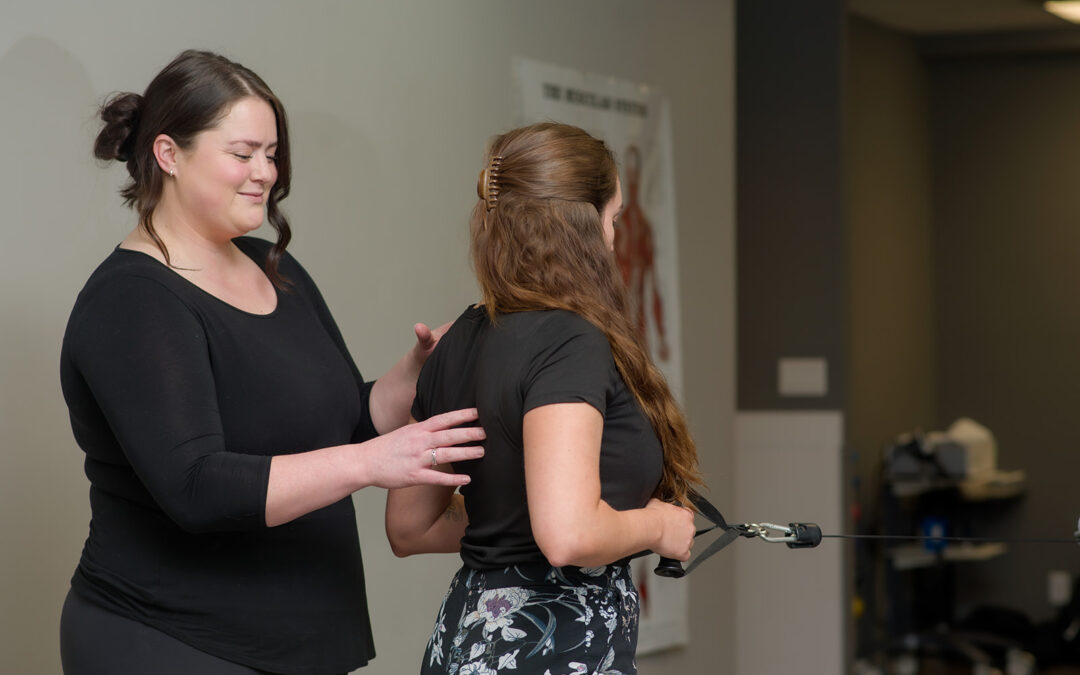
Injury Rehab and Prevention
Experience the power of Physio-Directed Active Rehab at Newleaf Total Wellness Centre. Our treatments go beyond the norm, aiming not only for recovery but also for the enhancement of your overall strength and resilience.

At Newleaf Total Wellness Centre, patient care is more than a commitment; it’s our calling. Since 2009, we’ve been a sanctuary for healing and strength. Under new leadership since 2022, Ed and DeVera have kept the founding vision of helping patients become Stronger, Braver, and Better. They have pioneered proactive approaches focusing on patient-centred care through evidence-informed treatment.

Why Physio-Directed Active Rehab Is Vital for You
In a world where high-risk jobs and athletic pursuits push your boundaries, Physio-Directed Active Rehab plays a crucial role in supporting your health and performance. We tailor our program to meet your unique needs and arm you with the tools to prevent injuries and enhance your overall wellness.
Whether you’re an athlete striving for peak performance, a healthcare worker managing occupational hazards, or simply an individual keen on injury prevention, we crafted our active rehab with you in mind. Our dedicated team of Athletic Therapists and Kinesiologists are guided by the expert knowledge of our physiotherapists. They will cater the sessions to your needs, ensuring you receive the care and guidance you deserve.
Tailored to Empower
Physio-Directed Active Rehab is led by a skilled Athletic Therapist or Kinesiologist but billed under physiotherapy services. The team tailors exercises to equip you with strength and resilience during the 45-minute one-on-one sessions. Our service addresses the needs of individuals across the spectrum. From health enthusiasts keen on injury prevention to high-risk job employees, like Canada Post workers and healthcare aides we have a plan as unique as you. For workers fortunate enough to have unlimited physiotherapy coverage under their insurance plans, it is like having a personal trainer in a private gym for one-to-one sessions.
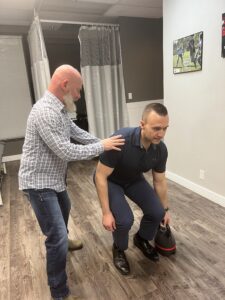
The Edge of Excellence
Here’s the Newleaf difference. We are not just a service but an interdisciplinary vision. We stand out as one of the few clinics in the area providing this type of program. Additionally, Physio-Directed Active Rehab is aligns with the CPTBC’s revised standards of practice to ensure exceptional public interest care. It’s an initiative resonating with our goal of helping our patients become Stronger, Braver, and Better.
Commitment to Success
After an initial assessment with one of our experienced physiotherapists, you’ll forge ahead with realistic goals. Ultimately, you will learn and enhance movement patterns for robust endurance and strength. Our promise to you is simple: personalized mentorship toward your best physical condition to keep you healthy and safe at work. Our vision at Newleaf Total Wellness Centre is about providing excellent service and also fostering an environment where patient care transitions into lifelong well-being.

Your Wins, Our Pride
Stories of success reverberate through the walls of Newleaf Total Wellness Centre. From the nurse who found new strength to combat the demanding shifts, to the care aide developing resilience against injury, your triumphs are the testimony of our service’s profound impact.
Take The Leap with Newleaf’s Physio-Directed Active Rehab
With expert advice grounded in years of practice, interdisciplinary vision, and human-focused care, we commit to guiding you on this restorative path. Book your session today to benefit from a personal trainer experience backed by the knowledge and education of our Athletic Therapists and Kinesiologists.
Join us at Newleaf Total Wellness Centre, where healing transcends treatment, and care is crafted with a vision of holistic well-being.
Contact us to schedule your first appointment and leap into the future of fortified well-being.
Disclaimer: You must have had an initial appointment with a Newleaf Physiotherapist before booking your Active Rehab session.
Written By: DeVera Nybo, MBA, CEO/Owner Newleaf Total Wellness Centre
—
Contact Information
- Phone: To schedule your session, call now 604-850-2511
- Email: Questions? Reach out via email [email protected]
- Address: Visit us at our location, A&B 2309 McCallum Road, Abbotsford, BC, nestled within the vibrant lands honoured by the hən̓q̓əmin̓əm̓ speaking peoples—xʷməθkʷəy̓əm (Musqueam), sel̓íl̓witulh (Tsleil-Waututh), and the Sḵwx̱wú7mesh-ulh Sníchim speaking peoples—Sḵwx̱wú7mesh Úxwumixw (Squamish Nation).

Women's and Children's Health
Picture this: you’re in the middle of a hearty laugh or a powerful sneeze, and suddenly, you feel it – that little, uninvited leak. It’s a bit embarrassing and not something you necessarily want to chat about at your next coffee meet-up. But here’s the deal: This is more common than you think, and it’s a sign that your pelvic floor may need some serious TLC.

Breaking the Silence
It’s high time we normalize conversations about pelvic floor issues. After all, the first step to solving a problem is acknowledging it exists. An essential part of this therapy is education and understanding the many roles played by your pelvic floor. At Newleaf Total Wellness Centre, we’re on a mission to bring the conversation about women’s health into the open, where it belongs.
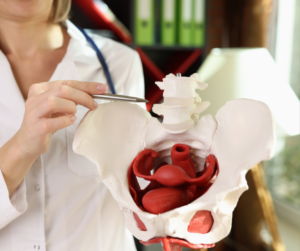
What on Earth is the Pelvic Floor, Anyway?
The pelvic floor is like a silent hero supporting your pelvic organs. It stabilizes the pelvis and spine, enhances sexual function, and supports bowel and bladder control. Think of your pelvic floor muscles as a hammock holding everything in place. Just like other muscles, they need care and, sometimes, rehabilitation.
Nearly 24% of people assigned female at birth will have pelvic floor dysfunction later in life. Its symptoms can manifest as frequent urges to urinate, constipation, or even a pressing fullness in the vaginal area. These are not merely inconveniences but problems that can affect one’s daily comfort and sense of well-being. Symptoms can range from discomfort and pain to constipation, frequent urination, and even sex-related distress.

The Unspoken Champion of Women’s Health – Pelvic Floor Physiotherapy
It is possible to sneeze without worry, laugh without hesitation and exercise without fear. How? Through a little-known champion of women’s wellness – pelvic floor physiotherapy.
Wellness warriors, fitness enthusiasts, new mothers – listen up! Pelvic floor therapy isn’t about Kegels (which can make your condition worse). Our therapists at Newleaf Total Wellness Centre use an array of techniques ranging from manual therapy, trigger point massage, and myofascial release to biofeedback and electrical stimulation. The treatments aim to strengthen and release these muscles to improve their function and, by extension, your life.
Our team of two physiotherapists and a kinesiologist are specifically trained in pelvic health. They are here to offer a comprehensive blend of therapy and tailored exercise prescriptions designed to get at and correct the root cause of issues. Treatments will help to:
- Strengthen and Release Muscles: Imagine regaining control and saying goodbye to unexpected leaks during your run or giggle fit.
- Boost Bladder and Bowel Control: Bid farewell to sprinting for the loo and hello to confidence.
- Enhance Sexual Pleasure: Nurture your intimate well-being by addressing discomfort and enhancing sensation.
- Bolster Postpartum Recovery: Bounce back stronger after childbirth with exercises geared towards new mamas.
- Improve Organ Support: Keep things lifted and supported, especially if you’re dealing with that annoying feeling of fullness or a vaginal bulge.

Wondering if Pelvic Floor Physiotherapy is Right for You?
Whether you’re a new mother navigating postpartum recovery, a dedicated yoga practitioner, or a woman looking to safeguard her healthcare future, pelvic floor health should be on your radar.
If you’ve experienced bladder leaks, struggles with postpartum recovery, painful intercourse, or other disruptions to your quality, know this – you’re not alone. Pelvic floor dysfunction plagues almost ¼ of women. It causes symptoms that range from mild inconvenience to severe discomfort and pain.

A Specialized Approach to Pelvic Floor Physiotherapy
Every person’s body is different, and every postpartum recovery is unique. This is why, when you visit Newleaf Total Wellness Centre, you’ll be given an individualized treatment plan. Our experts will review your symptoms, medical history, current habits, diet, exercise routines, and overall health in relation to your pelvic floor.
Our centre isn’t about running through a standardized checklist. We ask, we listen, and we care deeply. It’s a sanctuary where you’ll be greeted with understanding and leave with a solid game plan.
Beyond Postpartum Recovery
It’s not just new mothers who can receive help from these services. Fitness enthusiasts, women of all ages dealing with symptoms of pelvic floor dysfunction, and those who’ve had injuries or surgeries that affect these regions are all welcome. The benefits extend to sexual health, bladder and bowel control, and pain relief.
At Home with Technology
We understand that life is busy and making appointments can be tough, so Newleaf Total Wellness Centre recommends various home-based biofeedback technology options. These devices can help reinforce the exercises and techniques learned during therapy sessions, ensuring continual progression toward optimal pelvic floor health.

Your Wellness, Our Mission
We’re passionate about women’s wellness at Newleaf Total Wellness Centre. We stand ready to listen, assess, and guide you along the path to improvement. Whether you’re stepping into a gym postpartum or looking to regain confidence in your day-to-day activities, it’s time to say goodbye to “pee when you sneeze” moments.
Pelvic floor physiotherapy may be the key for many women to unlock a more active, secure, and comfortable life. Visit our website to learn more about our dedicated pelvic health services and our pelvic floor physiotherapists, Tajveer and Harman and consider starting your own success story.
For those eager to deepen your understanding, our resources draw from a breadth of respected institutions and specialists, including Beaumont, Cleveland Clinic, Loma Linda University Health, NAMS, Voices for PFD, and Mayo Clinic Health System, ensuring you’re backed by the best in the field.
Written by: DeVera Nybo, MBA, Owner/CEO Newleaf Total Wellness Centre
—
Disclaimer: The information provided in this blog post is for educational purposes only and is not a substitute for professional medical advice. Please consult with a healthcare provider before starting any new treatment.
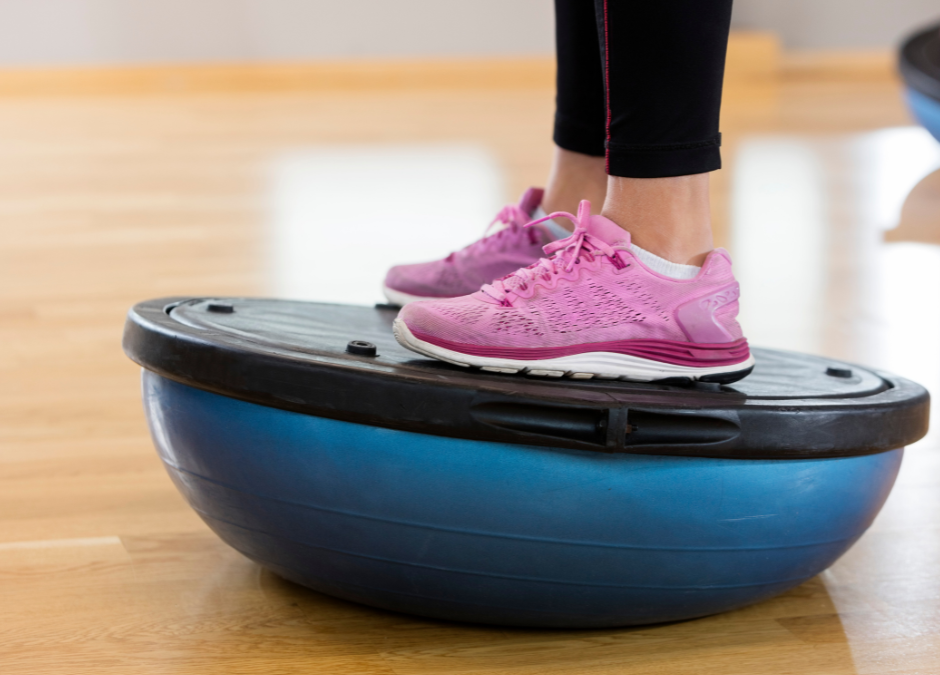
Injury Rehab and Prevention
Core stability is more than just a buzzword athletes toss around. It is at the foundation of a healthy, active lifestyle for everyone. Whether you’re an aspiring athlete, recovering from an injury, or seeking a healthier lifestyle, core stability should be at the heart of your fitness regimen. The core muscles represent more than sculpted abs; they are the foundation for all movement, strength, and balance. Whether performing a high-intensity exercise or just picking up groceries, a strong core delivers the power to strengthen and move muscles, allowing you to perform efficiently and effectively.
In this post, we’ll share insights from recent studies and provide a comprehensive overview of the core’s role in improving your game, functioning optimally in daily life, preventing injury and alleviating pain. Whether you’re curious about core workouts or searching for a solution to back pain, read on to discover how core stability can enhance your holistic well-being.

The Hidden Beneath: Core Muscles at Work
The core is your body’s powerhouse, where your center of gravity and movement originate. It consists of muscles that stabilize your hips, torso, and shoulders, functioning as a bridge between your upper and lower body.
Imagine your core muscles as the central link in a chain connecting your upper and lower body. Whether you’re hitting a tennis ball or cleaning the floor, the necessary motions either originate in your core or move through it. Without a stable starting point, these actions are less efficient and could lead to injury.
Having a strong and stable core has multiple benefits. It improves your posture, enhances daily functionality, and helps boost your athletic performance. Moreover, it reduces the risk of injuries and relieves back pain. It even improves balance and stability, particularly in older adults, reducing their risk of falls.
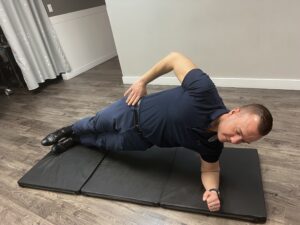
Core Stability: A Guard Against Injury
Recent studies, like the one titled “Effects of core stabilization exercise and strengthening exercise on proprioception, balance, muscle thickness, and pain-related outcomes in patients with subacute nonspecific low back pain,” highlight the profound impact core-stability exercises have on balance and even muscle thickness. Remarkably, these exercises increased stability and reduced pain, functional disability, and fear of movement among participants [1].
Another study on older women with low back pain discovered that core stability training significantly improved pain intensity, disability, and balance tests [2].
No athlete wants to be sidelined by an injury due to instability. High-performance athletes and fitness enthusiasts know the value of a strong core. It improves their strength and speed, enhances their agility and power, and reduces the risk of injury.
Furthermore, weak core muscles often lead to poor posture and are frequently at the heart of lower back pain problems. Strengthening them can help alleviate the discomfort and even reduce the risk of falls, which is particularly important for older adults. A strong core is the body’s armour, shielding it from unnecessary harm.

Daily Life Made Easier with Enhanced Posture
Consider the simple daily tasks that rely on core stability – from bending to put on shoes to looking over your shoulder or performing a task at work. Core stability affects nearly everything we do. Enhanced posture and alignment resulting from core strength exercises effortlessly support your daily life chores. Mayo Clinic experts support this claim with evidence that core exercises aid routine fitness and functional goals[3].
A Guide to Core Stability
One might think sit-ups and crunches are the way to a strong core. But to your surprise, these traditional exercises may not be the most effective for core stability and might even cause harm. Instead, try low-impact, functional exercises that engage multiple muscle groups.
Start with planks, side planks, or stability ball exercises, and focus on controlled movements. These exercises are particularly effective in building core strength [4].
Remember, increasing reps as your strength improves and working with professionals like physiotherapists, kinesiologists, or athletic therapists can offer tailor-made exercises to ensure your safety.
Suppose you’re noticing the symptoms of weak core stability, such as poor posture or frequent injuries, or simply want to enhance your performance in sports and daily life. In that case, consulting with a professional is a good idea. They can help you start a customized exercise routine that fits your needs.
Additionally, Institutions like the College of Physical Therapists of British Columbia, BC Chiropractic Association, Mayo Clinic, and Nationwide Children’s Hospital offer a wealth of information and resources on core stability[5]. They understand the significance of a strong core for overall health and injury prevention and provide in-depth guidance on maintaining core health.

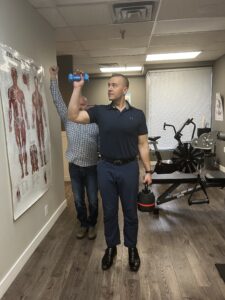
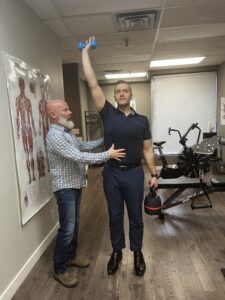
Keeping Your Core Promise
The first step is to understand the importance of core stability in fitness and wellness. Applying the knowledge through practice is next.
In closing, appreciate the core’s significance in your physical foundation. A stable core propels you forward in your athletic endeavours and anchors your daily movements in strength. Uncover the potential buried within your core and set the stage for a balanced, healthier life.
Encourage yourself to seek professional assistance to adopt a safe and effective core stability regimen. Remember, establishing a strong core isn’t an overnight affair; it’s a continuing commitment to your body’s center of power. Book an appointment today with a professional and begin your own core stability success story.
Written By: DeVera Nybo, MBA, CEO/Owner Newleaf Total Wellness Centre
—
References:
- Hlaing, Su Su, et al. “Effects of core stabilization exercise and strengthening exercise on proprioception, balance, muscle thickness, and pain-related outcomes in patients with subacute nonspecific low back pain: a randomized controlled trial.” BMC Musculoskeletal Disorders (2021)
- European Review of Aging and Physical Activity study on core stability and older women with low back pain.
- Mayo Clinic. “Core exercises: Why you should strengthen your core muscles.”
- Nationwide Children’s Hospital. “Core Stability: What Is It and Why Is It Important?”
- College of Physical Therapists of British Columbia (CPTBC).
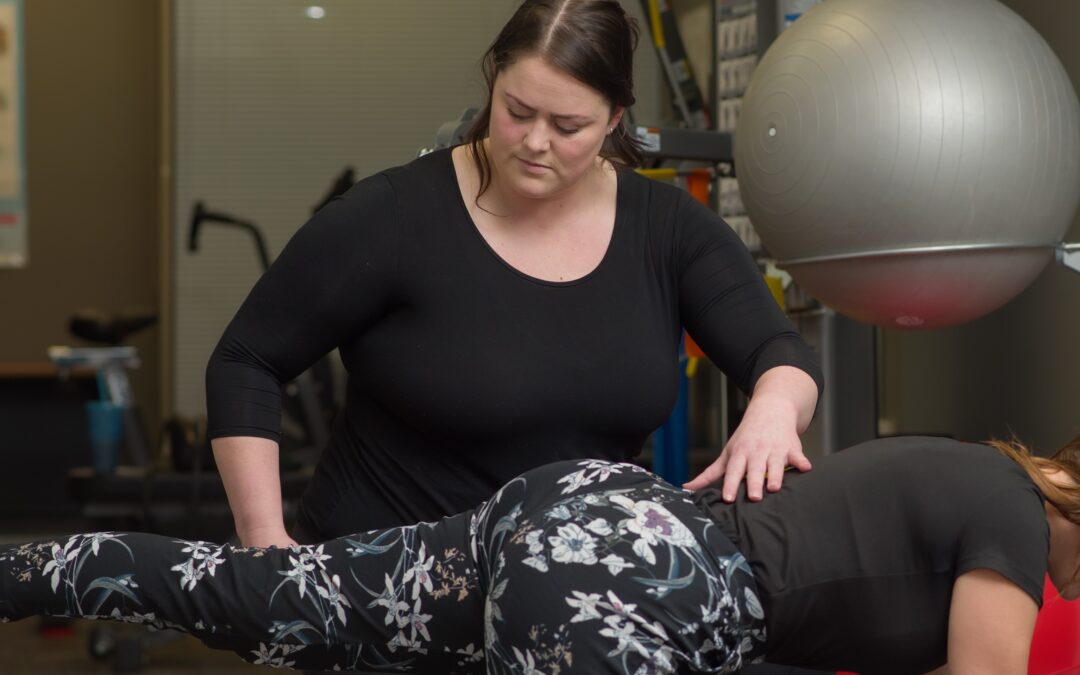
Injury Rehab and Prevention
Active rehab is the beacon of hope that can guide you to a physical recovery and also a restoration of your entire self. Recovering from an injury is more than just healing your body. It’s about getting your life back. Whether you’re an athlete, someone who’s been in an accident, or recovering from surgery, this is a powerful ally in your healing journey..
Active rehabilitation cleverly combines rest with specific exercises, tailored to help you heal physically, and emotionally too. Through a series of thoughtfully assigned activities, it helps rebuild your strength and brings you closer each day to where you aspire to be post-injury.
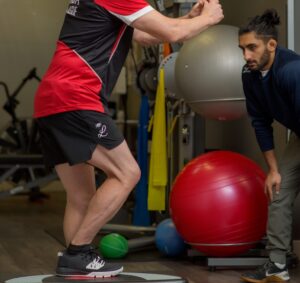
The Active Rehab Advantage
Active rehabilitation is a structured program developed by health experts to help individuals recover from injuries. It includes exercises like stretching, strength training, balance exercises, and specific movements. This tailored approach considers your injury, lifestyle, and goals. The benefits include quicker recovery, improved strength and flexibility, and better injury prevention.
This approach looks beyond the body, considering how physical health, mental well-being, and your environment are connected. Research shows that active rehab, especially for car accident or workplace injury patients, is crucial for recovery. Organizations like the Insurance Corporation of British Columbia (ICBC) and WorkSafe BC recognize the importance and effectiveness of these treatment interventions supervised by qualified professionals like physiotherapists.
Moving early can reduce pain and speed up recovery, contrary to the old idea prolonged immobilization is the key to healing. Active rehab fights immobility’s negative effects on muscles and mental health. Following a planned active rehab program can help you recover faster.

Success Stories
There are many impressive recoveries through active rehab. These cases show improvements like flexibility and strength, but also tell stories of regaining confidence and independence. With professional help, patients can return to daily activities sooner and with more confidence.
Each of us is as unique as our fingerprints, and our recovery pathways should reflect that individuality. Active rehab excels at customizing plans to meet different needs. Injured patients receive personalized plans that heal both body and mind. For cases like ICBC, participating in active rehab can be crucial for getting extensions and approved treatment plans. Athletes benefit from tailored training plans that help them return to their sport.
Partnering with Professionals for Your Recovery
Active rehab isn’t a solo journey. It requires skilled professionals to guide, support, and motivate you. These professionals are more than just therapists; they are mentors, educators, and your source of encouragement. Consider how teaming up with these professionals can lead to your recovery. By partnering with professionals dedicated to your overall well-being, you’re not just joining a program, you’re investing in a transformative process that goes beyond recovery.
Remember, your therapist functions as a collaborative partner in your journey towards wellness. Active participation in therapy is crucial for optimal results. Your dedication to homework tasks significantly enhances the effectiveness of the treatment. Recovery primarily occurs in the comfort of your home, with the clinic visits serving as checkpoints on your progress. Your therapist’s role is to provide guidance, support, and monitoring while ensuring the safety of your exercises and activities. Ultimately, the key to progress lies in your commitment and effort.
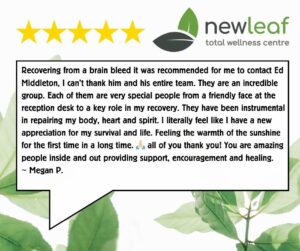
Call to Active Rehab
The path to recovery, though uniquely personal, doesn’t have to be solitary. By actively taking part in your rehabilitation and being the main character in your story, you can bring about many positive changes that reshape your recovery journey.
Whether you’re recuperating from an injury, preparing for surgery, or on a road to recovery from a car accident or on WorkSafeBC claim, consider active rehabilitation. Collaborate with experts, set targets, and see the transformation happen. Don’t settle for a slow recovery. Seize control of your healing journey by including active rehabilitation in your routine and recover faster.
Start your active rehabilitation today and redefine what recovery means to you. Book an appointment with Randi or Jaskiat here.
Written by: DeVera Nybo, MBA, CEO/Owner Newleaf Total Wellness Centre

Real Patient Success Stories
When visiting a paramedical clinic (physiotherapist, chiropractor, massage therapist, counsellor, naturopath, etc.), they may ask you to leave your credit card on file to access their services. This practice can raise many questions and concerns, such as how I am protected, whether it is legal and whether I can pay by another method. This blog post will provide all the information you need about leaving your credit card on file for paramedical services.
Why do I have to leave my credit card on file?
Leaving your credit card on file is customary in the healthcare industry. It allows the clinic to bill for services rendered in case your insurance does not fully cover the treatment or if you fail to attend your appointment. It also helps deter fraud by holding patients accountable for their appointments and associated costs.
Is it legal to ask for my credit card on file?
Yes, the law permits clinics to request your credit card on file, granted that they adhere to all relevant rules and regulations. Before leaving your credit card details on file, ensure that the clinic provides you with a privacy policy, which outlines what information they collect, how they use it, and how they protect it.

How am I protected?
Canadian and Provincial privacy laws (PIPEDA, HIPAA and PIPA) govern the use of personal information, including credit cards on file at healthcare facilities. Clinics must ensure that all patient data is kept safe and secure through various precautions, such as encrypted servers, password-protected access, and firewalls. Additionally, a reputable clinic will have privacy policies that adhere to all legal requirements for data protection.
To guarantee the safety of your financial information, inquire about a clinic’s payment and database system’s PCI compliance. The Payment Card Industry Data Security Standard is a set of requirements to ensure that all companies handling credit card information maintain a secure environment. By conforming to these standards, clinics strive to protect the confidentiality and integrity of sensitive data, thereby enhancing the overall security of their operations. As an example, Newleaf Total Wellness Centre uses the Jane App. Jane never stores a client’s credit card information directly on Jane’s servers. When staff enter a credit card in Jane, the data is instantly transferred to one of Jane’s payment processing partners through encrypted transfer. The clinic staff can only view the last four digits of your credit card, which means your sensitive information is not openly accessible.
Will the clinic refuse service if I don’t give them my credit card?
The answer to this question largely depends on the clinic’s policies. Some clinics may require your credit card on file to book an appointment. Others may refuse to provide services if payment is not received upfront. It’s always best to check with the clinic beforehand to understand their policies and requirements. A reputable clinic will not deny you service because you did not agree to submit your credit card information via an online intake portal. If entering your credit card information online makes you uncomfortable, look for a clinic that provides you with other options, like giving your card information over the phone, bringing it to the first appointment, purchasing a gift card, or paying upfront.
When will the clinic bill my credit card?
The clinic will bill your credit card if it discovers your health insurance did not cover the total amount or if you fail to attend your appointment. They may also charge a fee if you give less than 24 hours’ notice to cancel your appointment. Ensure you read and understand the clinic’s policies to know when they may charge your card.
It is worth noting that insurance companies, including ICBC and WorkSafe BC, will not pay for missed appointments, and billing them for such is fraudulent. Fees associated with missed appointments are always the patient’s responsibility.

What if I want to pay with another credit card, cash, or debit?
You can inform the clinic beforehand if you prefer to pay by another method. It’s always best to communicate your preferences upfront so the clinic can make the necessary arrangements. However, note that some clinics may still require your credit card on file to secure an appointment, even if you choose to pay by another method.
What if the clinic bills my credit card in error?
Let’s face it – mistakes happen! However, reputable clinics will take steps to avoid these errors by routinely reviewing the accuracy of claims processed. They should contact you if they find a problem. If there is a problem with your bill and you don’t notice it until after the payment process, call the clinic immediately. Most electronic medical record and billing systems (like Jane) make correcting issues and processing refunds to your credit card easy. If the dreaded mistake does happen, take steps to work through the fix with the clinic and ensure they outline how they will prevent similar errors from occurring again.
Conclusion
Leaving your credit card on file for paramedical services is a customary practice that can provide efficiency and security for both you and the clinic. It is essential to understand and the clinic’s billing and payment policies and how they use and protect your financial information. By staying informed and asking the right questions, you can ensure a smooth and stress-free experience when visiting your preferred paramedical clinic.
Written by: DeVera Nybo, MBA, CEO/Owner, Newleaf Total Wellness Centre
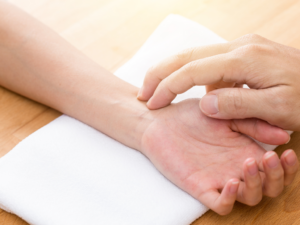
Chronic Conditions & Holistic Health
British Columbia regulates Traditional Chinese Medicine (TCM) as an official professional practice. Similarly, the country widely accepts Western medicine as a conventional healthcare approach. While both practices aim to deliver effective patient care, there are differences to expect when seeing a TCM practitioner compared to a Western medical doctor.
Treatment Philosophies of TCM and Western Medicine
One of the significant differences between Traditional Chinese Medicine and Western medicine lies in the treatment philosophy. TCM practitioners evaluate the patient’s body as a whole, considering their physical, mental, and emotional states. In contrast, Western medicine focuses on symptoms and aims to treat them with targeted medications or interventions. Traditional Chinese Medicine practitioners use natural remedies and techniques such as acupuncture, cupping, herbal medicine, and lifestyle changes to help the body heal from within. Meanwhile, Western medical doctors follow a science-based approach and prescribe medications, surgeries, and other conventional treatments to cure illnesses and diseases.

Diagnostic Techniques of TCM and Western Medicine
TCM practitioners use various manual diagnostic techniques to establish a patient’s underlying pathologies, including assessing the pulse, tongue, and body temperature. Traditional Chinese Medicine practitioners often diagnose invisible blockages in the flow of Qi, which is the life energy within the body. Western medical doctors’ diagnoses typically involve laboratory tests, imaging scans, and physical exams to detect specific diseases or ailments.
Timeframe and Treatment Length
Western medicine often offers quick-fix solutions to address symptoms and illnesses. In contrast, TCM practitioners take a more holistic approach, focusing on preventative care. Their treatment plans aim to strengthen the body over time, addressing the underlying causes of ailments and improving patients’ overall well-being. Traditional Chinese Medicine treatments, such as acupuncture and herbal medicine, typically involve multiple sessions spread out over time. This duration can range from a couple of weeks to several months.

Medications
Traditional Chinese Medicine practitioners use natural remedies, including herbs, minerals, and animal parts, which they prescribe in the right combinations to treat various ailments. However, natural remedies may have side effects and possible allergic reactions. In contrast, Western medical doctors use drugs that have undergone clinical trials, regulated by the pharmaceutical industry. These drugs may also have significant side effects and may interact with other medications.
Safety and Health Concerns
Safety and ethical concerns often arise with TCM practitioners due to their traditions, methods, and approach. However, the BC College of Traditional Chinese Medicine Practitioners & Acupuncturists oversee and regulate Traditional Chinese Medicine in British Columbia. Similarly, Western medicine may also come with risks, such as complications from surgery, side effects from medication, and infections from hospital care.

Conclusion
Traditional Chinese Medicine and Western medicine are two different approaches to healthcare with varying philosophies, diagnostic techniques, treatment lengths, medications, safety, and health concerns. Patients should always do their research and ask questions when seeking healthcare options.
If you have more questions about TCM, book a free consultation with Gloria.
Written By: DeVera Nybo, MBA, CEO/Owner, Newleaf Total Wellness Centre.

Therapy Options Explained
As individuals seek alternative and natural ways to approach their health concerns, Traditional Chinese Medicine (TCM) and naturopathic medicine have emerged as popular options. These approaches emphasize natural therapies and the body’s innate ability to heal itself. However, with the increasing popularity of these practices, patients may wonder how TCM and naturopathic medicine differ and how they are regulated. This blog aims to provide an unbiased and informative comparison of TCM and naturopathic medicine, including their similarities, differences, and potential risks.
About Traditional Chinese Medicine and Naturopathic Medicine

Traditional Chinese Medicine (TCM)
TCM has been around for over 2,000 years. It includes acupuncture, herbal medicine, cupping, tui na (massage), and nutrition. The practice is based on the concept that Qi, or energy, flows through the body along meridian pathways. Practitioners believe Qi influences all aspects of a person’s health, and TCM seeks to balance it through various methods.
TCM is effective in treating chronic conditions such as pain, digestive issues, allergies, and emotional stress. However, researchers need to do more studies to evaluate its clinical effectiveness. Research shows that acupuncture, a popular TCM therapy, relieves pain and may have other benefits, such as improving sleep and reducing anxiety.
One of the challenges of TCM is the lack of standardized training and regulation. While China highly regulates TCM, it is still an emerging field in other parts of the world, and practitioners in these areas may have varying levels of education or training.

Naturopathy
Naturopathy is a holistic practice that emphasizes using natural remedies to support the body’s natural healing mechanisms. Naturopathic doctors assess patients’ entire health history, including physical, mental, and emotional health, and develop personalized treatment plans using a variety of natural therapies.
Naturopathy uses a combination of therapies such as botanical medicine, clinical nutrition, hydrotherapy, homeopathy, naturopathic manipulation, acupuncture, and lifestyle counselling to improve the patient’s overall health. It has been proven effective in treating chronic conditions such as high blood pressure, diabetes, and asthma, preventing disease, and promoting general wellness.
Canada highly regulates naturopathy and recognizes it as a distinct primary healthcare system. Naturopaths must undergo rigorous training and receive licensing to practice from a governing body.
Similarities and Differences Between Traditional Chinese Medicine and Naturopathic Medicine
TCM and naturopathic medicine share similarities in their approaches to treating health concerns. Both systems believe in the body’s ability to heal itself. They use natural therapies to promote health and prevent diseases from developing. Additionally, they both emphasize the importance of addressing the root causes of illness and health issues, not just the symptoms.
The main difference between TCM and naturopathy is their approach to healing. TCM seeks to balance the energy flow throughout the body. At the same time, naturopathy aims to support the body’s natural healing mechanisms using natural remedies.
TCM uses acupuncture and herbal medicine as its primary therapies, while naturopathy uses a variety of therapies.
Regulations of Traditional Chinese Medicine and Naturopathic Medicine
TCM and naturopathic medicine differ in how they are recognized and governed. TCM is not currently a regulated healthcare profession in Canada. However, some provinces have associations that set voluntary standards of practice. The College of Traditional Chinese Medicine Practitioners & Acupuncturists of British Columbia governs TCMs in British Columbia.
The government regulates Naturopathic medicine in several Canadian provinces, including British Columbia, Alberta, Saskatchewan, Manitoba, Ontario, and Northwest Territory. These regulations ensure patients’ safety regarding practitioners’ training, education, and professional standards. Naturopaths in regulated provinces can prescribe designated drugs if they have completed a course approved by the College relating to drug prescription.

Potential Risks of Traditional Chinese Medicine and Naturopathic Medicine
While TCM and naturopathic medicine are typically practical and safe, there are potential risks associated with these practices.
TCM risks include minor side effects from herbs or acupuncture, as well as the possibility of misdiagnosis or improper treatment by an unlicensed or unqualified practitioner. Naturopathic medicine risks may include allergic reactions to supplements or botanical products or the chance of adverse interactions between prescribed medications and natural treatments.
Efficacy of Traditional Chinese Medicine and Naturopathic Medicine
The efficacy of TCM and naturopathic medicine is an area of ongoing research and debate. Many studies have shown positive outcomes for both practices in treating various health concerns.
Conclusion
Alternative medicine provides patients with an array of treatments that support the body’s natural healing processes. People have used TCM and naturopathic medicine for centuries. Although both systems share similarities, they also have differences in their diagnostic and treatment approaches. These differences give patients options, allowing them to choose a treatment that matches their unique needs. Patients considering these approaches should seek qualified and licensed practitioners and be aware of potential risks associated with these practices.
If you have questions or want to find out which is right for you, book a free TCM consultation with Gloria or a Naturopath consultation with Dr. Cerf.
Written by: DeVera Nybo, MBA, CEO/Owner, Newleaf Total Wellness Centre

Therapy Options Explained
When caring for our health, we can take many approaches to achieve our desired outcomes. One popular way to improve our well-being is by working with a qualified nutrition professional, such as holistic nutritionist or dietitian. While they may seem interchangeable, many differences between these two types of professionals can impact your healthcare journey. In this post, we will dive into the world of holistic nutritionists vs. dietitians to help you better understand which approach may be right for you.
Differences Between a Holistic Nutritionist and a Dietitian in Regulation and Coverage
One of the primary differences between a holistic nutritionist and dietitian is how they are regulated and covered by insurance plans. While the government fully recognizes and regulates dietitians, holistic nutrition professionals are not. Dietitians are legally entitled to provide nutritional therapy in clinical settings such as hospitals, diabetes clinics, or cancer centers. On the other hand, holistic nutritionists usually focus on educating patients so that they have a greater hand in their own health. Additionally, MSP typically does not cover private practice dietitians, but extended health benefit plans usually cover their fees. In contrast, most insurance companies do not cover holistic nutrition services. Still, some companies like Greenshield and Manulife will cover their fees under “Nutritional Counselling.”

Approach to Health and Well-being
Another critical difference between a holistic nutritionist and dietitian is how they approach health and well-being. While both professionals focus on whole foods and nutrition to improve wellness and health conditions, holistic nutritionists approach health and well-being from a whole-person perspective. Using nutritional education as their primary tool, holistic nutrition professionals emphasize each person as unique. They perceive health as a manifestation of the intricate interconnectedness between an individual’s physical, mental, emotional, spiritual, and environmental aspects. Consequently, holistic nutritionists consider all relevant factors when providing care to clients. By contrast, dietitians employ scientific research to convey the science of nutrition in a manner that is accessible and understandable. They tend to focus more on using tools like the Canadian Food Guide to help their clients. This guide suggests that everyone’s nutritional requirements are identical and do not necessarily consider individualized needs.

Education and Qualifications
Regarding education and qualifications, there are also differences between holistic nutritionists and dietitians. Registered Dietitians (RDs) typically earn a Bachelor of Science (BSc) degree in Food, Nutrition, and Health. In the final year of their program, they usually complete a few nutrition courses to enhance their knowledge and expertise further. Meanwhile, holistic nutritionists take courses in eastern and biological sciences, metabolic typing and other subjects to provide a more integrated approach. Dietitians undergo a rigorous peer-reviewed registration process before using the RD designation. Holistic nutritionists may be certified by governing bodies like CANNP, CSNN, or NANP, but it’s not mandatory. It’s important to note that both groups of professionals can offer various levels of experience and continuing education.
So Which is Better for Me? A Holistic Nutritionist or a Dietitian
While both holistic nutritionists and dietitians can help people improve their health, they take different approaches to achieve those outcomes. Dietitians are legally licensed to work in clinical settings and take a science-based approach to nutrition. Meanwhile, holistic nutritionists consider a holistic view of their clients, using nutritional education to empower them. Whatever strategy you choose, it’s important to consider your individual needs and goals. By understanding the differences between holistic nutritionists and dietitians, you can make an informed decision regarding your health and well-being.
To learn more about holistic nutrition, book a free consultation with Lindsey.

Real Patient Success Stories
A common question at Newleaf Total Wellness Centre is, “Is this covered?”. When you have coverage for a service, your health plan will contribute payment towards some or all of the costs. Do you ever wonder why your clinic staff can’t tell you what your health insurance coverage is for chiropractic, physiotherapy, massage therapy or other services? You’re not alone. In this post, we will explore why that is the case and look at some steps you can take to understand your exact healthcare coverage better.
Why your clinic can’t tell you about your healthcare plan coverage.
It’s important to understand that your personal health information, including service utilization, is highly confidential. This information is available only to you and your benefit provider. Clinics and healthcare providers can only access payment information without any other details. When the clinic submits your treatment for coverage to your insurance provider, the system will tell them only if you have coverage – yes or no. If you have coverage, it will let the clinic know how much your plan will cover for the treatment submitted. It will not tell the clinic your total amount of coverage, how much your deductible or patient portion is, or any other details about your plan.

But my dentist can check to see if a treatment is covered.
While dentists may need to contact your insurance provider for pre-approval for crowns or other major dental work, they do not do so for routine treatments like cleanings and fillings. Similarly, your physiotherapist, chiropractor, RMT or acupuncturist cannot get pre-approval before you arrive for routine appointments such as a one-hour massage or fifteen-minute chiropractor appointment.
Your dentist cannot tell you how much your plan will cover or how much you have used to date. Like your clinic, they only receive information on whether the treatment is covered and how much your plan will contribute to that treatment.

The law.
Most believe that our medical and health information should remain private and protected. Under the PIPA (Personal Information Protection Act) and HIPAA (Health Insurance Portability and Accountability Act of 1996), BC Provincial and Canadian Federal laws give you rights over your personal and health information.
These laws also establish rules on who can see your health information. The rules apply to health plan administrators, insurance companies, employers, and government programs providing healthcare. Additionally, these laws cover most healthcare providers who process electronic transactions, such as billing your health insurance, including doctors, clinics, and hospitals.
How do I know what my coverage is?
Many individuals have healthcare coverage through their employer or spouse’s employer. The coverage and payments provided by your health plan depend on the details of the plan chosen by your company. It’s important to understand that every plan, even those offered by the same insurance company, provides different coverage for paramedical services, tests, and prescriptions. This variation is because there are many kinds of plans to choose from, and companies consider cost when selecting the most suitable option for their employees. Paramedical expenses refer to medical services or products received from licensed healthcare professionals who are not medical doctors or nurses. Examples of paramedical practitioners include acupuncturists, chiropractors, massage therapists, physiotherapists, podiatrists, and more.

Where Can I Find the Information?
Your paramedical coverage information can be found under your healthcare plan’s ‘Paramedical Services’ list. Please be aware that certain limits may apply to your coverage, such as a maximum number of visits or a maximum dollar amount covered per treatment or service. To review the limits specific to your coverage, refer to the ‘Limits’ section in your coverage details.
It is crucial to familiarize yourself with the coverage provided by your benefits plan and the out-of-pocket expenses for which you are responsible. Knowing what your plan covers will help you to avoid unexpected costs and disappointment. We recommend requesting an updated employee benefits booklet from your company to obtain information on maximum coverages and the disciplines covered.
For detailed information about your coverage, including the amount used and remaining, visit your benefit provider’s website. You must set up a personal profile with a username and password to securely access this information through their online portal or mobile app.
How Do Insurance Companies Decide How Much to Cover?
Insurance companies establish reasonable and customary (R&C) limits, which represent the payment range for specific health-related services or medical procedures. It’s important to note that these limits are often based on outdated average cost reports and may not accurately reflect current costs. Consequently, you may have to pay more for a service than your benefits cover.
Consider this example: Suppose you book a massage costing $130, but your insurance company’s R&C amount for this service is $100. Assuming your workplace plan covers 80% of massage therapy treatments, you would be eligible for a reimbursement of 80% of the R&C amount, equalling $80. You would have to pay the clinic $50.
More about other types of healthcare insurance coverage.

Residents of British Columbia are covered by the Provincial Medical Services Plan (MSP). MSP contributes $23 per visit for acupuncture, chiropractic, massage therapy, naturopathy, non-surgical podiatry, and physical therapy for people on income assistance, disability assistance, and hardship assistance. There is a combined limit of up to 10 visits per calendar year. However, it is crucial to mention that the government does not cover any charges related to extra billing, and this coverage is only available to some low-income recipients. If you believe you should qualify for MSP’s $23 contribution towards your patient fees, ask your clinic to check your eligibility online. Please note that the only information your clinic will receive is whether you are eligible.

Suppose you have been involved in a car accident. In that case, you are eligible for a specific number of treatments that can last up to 12 weeks after the date of the accident. ICBC covers 12 Acupuncture appointments, 25 Chiropractic appointments, 12 Registered Clinical Counseling appointments, 12 Registered Massage Therapy appointments, 25 Physiotherapy appointments and 12 Kinesiology or Athletic Therapy appointments.
If you choose a clinic that directly bills ICBC, the clinic should be able to inform you of how many treatments you have left. However, it is always your responsibility to know how many treatments ICBC has approved for you and how many are left. You are always responsible for any treatments you receive that insurance does not cover.
ICBC has approved service coverage up to a certain fee per treatment; the patient must pay the remaining user fee.

If you get injured at work, it’s important to know the available options for coverage and support through WorkSafe BC. The crucial first step is notifying your employer and WorkSafe BC after the incident.
Physiotherapy
For physiotherapy, we advise scheduling an appointment with one of the approved clinics within the WorkSafe BC provider network. Even before your claim is approved, WorkSafe BC will cover the cost of your initial appointment. However, if you choose a physiotherapist not contracted with WorkSafe BC, you must pay for the visit and then get reimbursement from WSBC. Therefore, we recommend not to book subsequent appointments until your claim is approved unless you are willing to pay for them.
Registered Massage Therapy
Before getting treatment from a Registered Massage Therapist (RMT), you must obtain a referral from your doctor. Once your WorkSafe BC claim is accepted, you are entitled to up to six treatments within the first eight weeks of your injury. When choosing massage therapy, you should pick a provider who will directly bill WorkSafe BC and submit reports. To find an RMT, please visit the Registered Massage Therapists Association of BC website and use the WorkSafe BC filter. However, if you decide on a provider who does not bill WSBC directly, you must pay for your visit and then ask for reimbursement. Please note that WSBC will reimburse you at predetermined rates; any remaining balance will be your responsibility.
Referrals
WorkSafe BC does not require referrals for chiropractic, acupuncture, or naturopath treatments, and you may be entitled to receive up to eight weeks of treatments once WorkSafe BC has approved your claim. If you choose a provider who does not bill directly to WorkSafe BC, you must pay for the visit and then seek reimbursement. Again, remember that WSBC will reimburse you at established rates, and any difference will be your responsibility.
Your case manager must approve all dental work before you can receive it unless it is an emergency. WorkSafe BC covers emergency room visits, short- and long-term stays, day surgery, dressing changes, casting, and diagnostic imaging.
If you choose a clinic that directly bills WorkSafe BC, the clinic should be able to inform you of how many treatments you have left. However, it is always your responsibility to know how many treatments WorkSafe has approved for you and how many are left, as you are always responsible for any treatments you receive that insurance does not cover.
Conclusion
Understanding all associated fees and insurance coverage before attending paramedical services is essential. For those with limited financial means, MSP may contribute a small amount towards your treatment. Those who have had a motor vehicle accident may receive coverage through ICBC, and WorkSafeBC may provide coverage following a workplace accident.
The long and short of it is that the amount of insurance coverage you are entitled to depends on several variables. You must know your entitlements because privacy regulations restrict clinics from accessing most of this information.
We hope this blog post has explained why your clinic may be unable to inform you about what your insurance will cover and how financing paramedical services works.
Please note that this information is intended to provide educational insights and should not replace any specific guidance or advice provided by a healthcare professional or plan administrator.
Written by: DeVera Nybo, MBA CEO/Owner Newleaf Total Wellness Centre

Therapy Options Explained
Understanding Manual Osteopathy
Manual osteopathy is a patient-centred system of healthcare that uses hands-on techniques to balance all body systems. They focus on making sure your bones, muscles, and other parts work well together. Unlike regular doctors who might only treat one problem at a time, osteopathy looks at how all parts of your body are connected. The goal is to improve your overall health by treating you as a whole person. This approach believes keeping your body, mind, and spirit in balance is important for good health. Unlike conventional medicine, which often isolates and treats symptoms independently, manual osteopathy considers the position and health of all body tissues, including the organs, as linked.
How Our Feelings Affect Our Bodies
It’s well-known that what we feel emotionally can change our physical health. Stress, anxiety, grief, and other emotions don’t just affect our minds. They can show up in our physical health, leading to muscle tension, hormonal imbalances, and, yes—even the displacement of organs. The concept might seem far-fetched, but think of that “knot” in your stomach during moments of fear or the feeling of your heart being “heavy” with sorrow. Our body will often mirror our emotional state.

Gagandeep Watts, MO
Visceral Manipulation in Osteopathy
Osteopaths have a particular way of treating the body called visceral manipulation. They gently move and fix restrictions in the organs and tissues around them. This gentle manual therapy carefully works with the internal organs (viscera) and their connective tissues to free up restrictions and improve the organs’ ability to function effectively. By doing so, manual osteopaths help restore balance and ensure that each organ sits correctly within the body. This therapy mitigates discomforts that might stem from displacement due to emotional stress.
Working With Other Health Care Professionals
Osteopaths also think about the mental causes of physical problems. By understanding how the mind and body connect, osteopaths can help people heal more completely. Treatment plans might include working alongside psychologists or counsellors when necessary, proving the power of interdisciplinary cooperation in achieving well-being.
Manual osteopathy offers significant benefits but shines exceptionally bright when complementing other treatments. It can fill gaps that regular medicine might miss and help patients who haven’t gotten better with other treatments.

The Healing Environment of Osteopathy
An osteopath’s office is a sanctuary where people can get help for their emotional and physical pain. It can be a source of comfort for those who are suffering inside and show them a way to get better. Individuals who live in the aftermath of emotional upheavals and carry the invisible weight of their feelings can find comfort and relief through the hands of a skilled manual osteopath. Relief is achievable and expected through the thorough and compassionate application of manual osteopathy techniques.
Final Thoughts
Feelings are powerful and can affect our bodies and minds. Whether you are burdened by physical discomfort or emotional strain, seeking the expertise of a manual osteopath might open doors to a level of wellness previously impossible.
As we move towards a future where holistic and conventional medicine collaborate more closely, the role of manual osteopathy will undoubtedly become even more meaningful. It carries the potential to heal and teach us about something we often forget. Our bodies and minds are inseparable, and caring for one means nurturing the other.
To book a free 15-minute consultation with Gagandeep Watts, MO, click here.
Written By: DeVera Nybo, MBA, CEO/Owner Newleaf Total Wellness Centre
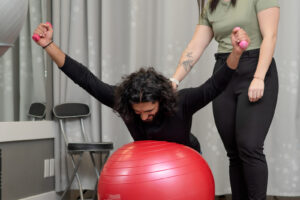
Therapy Options Explained
For anyone involved in sports or fitness or undergoing rehabilitation for an injury, it’s crucial to know about the various treatment options available to help with recovery and injury prevention. Athletic Therapy and Kinesiology are two fields often mentioned in the same breath. Still, they each offer unique benefits and approaches to rehabilitation. If you’re wondering which path to take for optimum recovery, you’re not alone. This blog post aims to explain each practice and aid you in making an informed decision for your healthcare needs.

What is Athletic Therapy?
Athletic Therapy treats acute and chronic muscle, bone, and joint injuries. Certified athletic therapists receive training in the prevention, emergency care, assessment, and rehabilitation of musculoskeletal injuries. They use various techniques – including manual therapies, therapeutic modalities, corrective exercises, physical reconditioning, taping, and bracing – all geared towards a speedy and safe return to activity, whether for everyday functioning or competitive sports.
You might spot athletic therapists attending to injuries on the sidelines at sports games, ready to provide emergency care. Their expertly honed skills make them vital in professional sports teams where quick and decisive action can make all the difference.
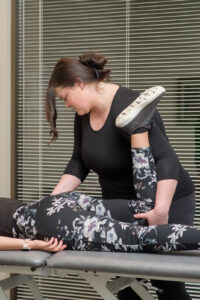
What about Kinesiology?
Kinesiology takes a bird’s-eye view of body movement. This science examines exercise, human movement, and how physical activity affects overall health and wellness. Rather than focusing on injury treatment, kinesiologists usually provide movement analysis and physical ability assessments. They promote active lifestyles and injury prevention through carefully designed exercise programs.
Kinesiologists work in various settings, including clinics, fitness centers, corporations for workplace health, and research. They contribute significant insights into how people can harness movement and exercise to enhance well-being.

Comparing Education and Certification
To become a certified athletic therapist, candidates must complete a dedicated Bachelor’s Degree program with at least 1200 hours of practical training in diverse settings and pass a rigorous certification exam. Kinesiologists generally require a Bachelor’s Degree in Kinesiology or a closely related field but do not have the same focused training specifically for injury assessment and rehabilitation.
Insurance Considerations
Before choosing your therapy path, it’s essential to consider insurance coverage. Insurance plans may not cover Athletic therapy and kinesiology services, so check what your policy allows for. ICBC funds both, but a Physio-Directed Active Rehab Program could be a viable alternative if you’re dealing with an injury not covered by accident insurance, and you don’t have coverage under your extended benefits.
Such programs, typically involving an Athletic Therapist or Kinesiologist overseen by a Physiotherapist, may be billable under physiotherapy benefits, meaning more likelihood of coverage by insurance providers like Manulife, Canada Life, Sunlife or Pacific Blue Cross.

Kinesiology or Athletic Therapy: Making the Right Choice for You
The right choice between Athletic Therapy and Kinesiology depends on your specific needs and goals. An Athletic Therapist could be your best choice if you focus on expertly navigating the road from injury to activity with precision. Conversely, suppose you want to enhance your movement, build strength, and foster recovery through regular physical activity. In that case, kinesiology might be the way to go.
The bottom line comes down to compatibility. Ensuring that your therapist has the requisite qualifications, experience, and an approachable personality is as important as their professional capabilities. Trust, comfort, and confidence in your therapist’s expertise are non-negotiable in your recovery journey.
—
This post aims to clarify the distinctions between Athletic Therapy and Kinesiology, offering insight to athletes, fitness enthusiasts, and patients alike for better-informed health and recovery choices.
If you have questions or need personalized guidance, don’t hesitate to contact our clinic or book with one of our healthcare professionals, who can provide tailored advice based on your unique situation and goals.
Written by: DeVera Nybo, MBA, CEO/Owner, Newleaf Total Wellness Centre.

Injury Rehab and Prevention
If you’re reading this, chances are you’ve encountered the frustrating plateau that often accompanies the road to recovery. As an ICBC client or someone who’s experienced injury, you know all too well that healing is not always linear. Despite following medical advice, sometimes progress just stalls. But why does this happen, and more importantly, what can be done to overcome a setback in your injury recovery? This blog post will address these crucial questions and offer actionable strategies to help you overcome injury setbacks.

Find a Therapist You Trust to Help Overcome a Setback in Your Injury Recovery
One of the cornerstones of effective recovery is working with a healthcare provider you trust. A strong patient-therapist relationship leads to better engagement, more meaningful therapy sessions, and, ultimately, improved outcomes. If your recovery has plateaued, evaluate your partnership with your therapist.
Do you feel heard and understood during your sessions? Is your therapist attentive to your concerns and adjusting treatments accordingly? Trust is essential—don’t hesitate to seek a second opinion or find a new therapist if it doesn’t feel right. Remember, this is about your healing, and you deserve a guide who resonates with your recovery goals.
Overcome a Setback by Attending Your Appointments
It’s not uncommon for life to get in the way of recovery. Missed appointments, however, may be the culprit behind a stalled recovery process. Consistency is vital when it comes to rehabilitation and healing. Each session builds upon the last; skipping appointments can disrupt this progression.
Recommit to attending all scheduled appointments or discuss with your therapist a suitable schedule that accommodates any constraints you might have. Being proactive and reliable with your presence can play a significant role in getting your recovery back on track.

Attending your scheduled appointments to avoid setbacks
Be an Equal Partner in Your Recovery
Recovery is a two-way street; it requires the expertise of your therapist and your active participation. To regain momentum, adopt the mindset of an equal partner in your treatment. Be candid with your therapist about pain levels, discomfort, or concerns. Provide feedback on what’s working and what isn’t. The more information you share, the more your therapist can tailor the recovery plan to fit your specific needs.
Empower yourself by asking questions and understanding the rationale behind each aspect of your treatment. When you know the ‘why’ behind each exercise or recommendation, it likely becomes more meaningful and integral to your routine.

The therapist/patient relationship is crucial to overcome injury setbacks.
Do Your Homework to Overcome Injury Setbacks
Often, recovery extends beyond the confines of the therapist’s office. “Homework,” such as exercises, stretches, or lifestyle changes, is frequently prescribed to complement in-clinic treatment. If you’ve become lax with your at-home program, now is the time to reinvigorate your commitment.
Implement strategies to ensure you do the work: set reminders, create a dedicated exercise space, or find a recovery buddy to keep you accountable. Your diligence with these tasks can dramatically influence the speed and effectiveness of your recovery.
Conclusion
Setbacks in recovery can be discouraging, but identifying the reasons behind stalled progress is the first step toward regaining momentum. By fostering a trustworthy relationship with your therapist, attending all your appointments, becoming an active participant, and diligently doing your prescribed “homework,” you’re paving the pathway to your successful recovery.
Your commitment to these strategies rallies you back to health. It equips you with resilience and a proactive approach to healing. Remember, your recovery is a personal journey, and you hold significant power in influencing its direction and destination.
Still have questions? Visit our learning centre for more answers to common questions or book an initial assessment with one of our physiotherapists.

Healthy Habits & Lifestyle
Ergonomics has become a buzzword in office cultures worldwide. Supporters see ergonomics as the silver bullet for aches, pains, and productivity in the workplace. The promise is attractive: tailor your work environment to fit your physique, and you’ll work healthier and happier. Yet, my own experience and evidence gathered from various studies suggest that the reality of ergonomics is far more complex and, at times, disappointingly ineffective.
When Ergonomic Principles Fail Us
My struggle with ergonomics is personal. Although I carefully followed ergonomic guidelines, I’ve suffered just as much as those who don’t bother. This realization prompted me to question —why, with all its logical foundations, doesn’t ergonomics deliver on its promise?
Misinterpreting Our Body’s Signals
It’s easy to blame long hours or stress for that gnawing neck pain or the throbbing in your wrists, overlooking the possibility that your perfectly set ergonomic desk might be the culprit. Our symptoms often get misinterpreted, and the ergonomic setups we trust might not address the root cause of our discomfort.

Ergonomics and Neck Pain
The Problem of One-Size-Fits-All
Ergonomics generally operates under a one-size-fits-all theory, but here lies a critical flaw. Because there are so many individual variations, standard ergonomic solutions often fall short. Our bodies, habits, and preferences are unique, so our approach to creating a healthy workspace should also be.
The Nuances of Work Tasks
The complexity of specific jobs can make ergonomic principles doubtful. Some tasks demand movements or postures that no ergonomic guideline has accounted for. Work environments are varied and complex, and focusing solely on ergonomics can be like wearing blinders, ignoring the complicated nature of human tasks.
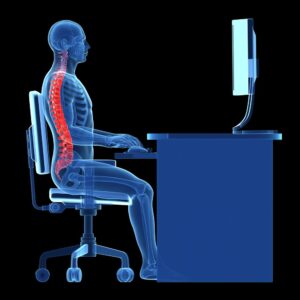
Spinal Alignment Using Ergonomics
Implementation of Ergonomics Isn’t Everything
Following ergonomic guidelines is important, but it’s no cure-all. I’ve seen first-hand how strict implementation doesn’t prevent injuries or illnesses. It’s not just about setting up an ergonomically correct workstation; it’s about how you use ergonomics and your actions beyond the desk.
.Productivity at Risk
Productivity suffers in the face of poor ergonomics. If left unchecked by inadequate ergonomic setups, muscle discomfort can lead to larger health issues, which clearly impacts work efficiency. Additionally, when comfort is compromised, so too is the quality and focus of our work.

Change positions often.
The Alternative Path to Ergonomics: Counterbalance and Adaptability
What should we do if traditional ergonomics aren’t the answer? Considering what our body goes through during the day provides a start. For instance, after hours of sitting with hunched shoulders and a downward gaze, try laying on your stomach in the evening, propped up on your elbows. This simple pose reverses the day’s harmful postures, opens your shoulders, and encourages a natural arch in your back.
Change your position frequently when sitting. Our bodies aren’t designed for stagnation. Consider including regular movement to counteract the inactive positions that ergonomics tries to perfect but sometimes cannot accommodate.
Beyond Ergonomics – A Holistic View
This blog is not a dismissal of ergonomics as a whole but a call to recognize its limitations and adapt it to fit individual needs. A successful approach to workplace well-being must be as dynamic and many-sided as the people it intends to help. It should include the environment and the needs of each human body.
Incorporating frequent movement, mindfulness of posture throughout the day, and exercises that counteract work-induced strain can complement the ergonomic framework and lead to healthier, more sustainable work habits. Ergonomics may not be the standalone solution we once thought. However, it still holds value as part of a broader, more personalized strategy. It’s about finding balance, adapting, and listening to your body’s needs. Your health, happiness, and productivity depend on it. To learn more about your body’s needs, book a functional movement assessment with one of Newleaf’s physiotherapists here.
By: DeVera Nybo, MBA

DeVera Nybo, CEO/Owner Newleaf Total Wellness Centre

Real Patient Success Stories
If you’re reading this blog, you want to know which is the best clinic in the Abbotsford area. At Newleaf Total Wellness Centre, we serve over 20,000 patient appointments per year. As we are a bustling facility, there may be times when we cannot serve our community. This could be due to a lack of services, scheduling conflicts, waitlists, or patients needing to attend a location closer to their home. In keeping with our philosophy of putting patient needs above all else, we researched and compiled a list for you. Our goal was to create a comparison based on pricing, practitioner availability, location(s), types of services offered, disciplines available, reviews, years in operation, direct billing to insurance companies, and more. If we are not the right resource for you, we hope this list will aid in finding one that is. So, grab a coffee and read on to find a health and wellness facility that best suits your needs.
1. Altus Chiropractic & Physiotherapy Clinic

Altus Chiropractic & Physiotherapy Clinic
Clinic Services and Pricing
Altus Chiropractic & Physiotherapy is open Monday to Friday from 9 am to 6 pm.
Altus Chiropractic & Physiotherapy is open Monday to Friday from 9 am to 6 pm. Nine practitioners offer services in chiropractic care, massage therapy, and physiotherapy.
While Altus Chiropractic & Physiotherapy provides limited services, the Abbotsford community has consistently voted it the best Chiropractic, Physiotherapy and Massage clinic in town. They do not advertise pricing on their website, making price comparisons impossible.
Altus direct bills for most insurance plans, including ICBC, WorkSafe BC and MSP.
Patient Resources and Practitioner Availability
The Altus Chiropractic & Physiotherapy website offers informational blogs and podcasts on different topics related to health and wellness featuring interviews with their practitioners. However, the company does not provide an online patient booking portal, so patients must call the clinic during business hours to book appointments.
Google Reviews and Ratings
Altus has a high rating on Google reviews, with an average rating of 4.9 stars out of 5.0 in 86 reviews. The positive reviews emphasize the staff’s welcoming nature and the practitioners’ skills.
2. Pacific North Wellness Clinic

Pacific North Wellness Clinic
Clinic Services and Pricing
Pacific North Wellness is open Monday to Friday. It offers competitive and transparent pricing compared to other multidisciplinary clinics in the area. Their rates for initial appointments range from $85 to $160. This facility has ten practitioners, offering a wide variety of services, including chiropractic care, physiotherapy, massage therapy, kinesiology, and athletic therapy. It also provides unique classes and services, including yoga, breastfeeding support, pelvic floor physiotherapy and facial stretching.
Pacific North Wellness offers direct billing to most major insurance companies, including ICBC; however, they do not take WorkSafe BC patients.
Patient Resources and Practitioner Availability
Pacific North Wellness provides information on each discipline and treatment offered, including what patients can expect during their visit. However, they do not have any other resources or blogs on their website for patients to get additional information.
Their online booking portal (Jane App) is user-friendly and easy to navigate, allowing patients to book appointments at any time, and practitioner schedules are clearly visible, with many available appointment times.
Google Reviews and Ratings
Pacific North Wellness has an excellent rating on Google (5 out of 5 stars in all 91 reviews), which speaks to its quality of care. Patients have left positive reviews, praising the facility’s cleanliness, professionalism, and friendly staff. It’s important to note that a clinic with so few reviews may not have had the chance to discover its weaknesses and make improvements.
3. The Apollo Clinic

The Apollo Clinic
Clinic Services and Pricing
The Apollo Clinic is open six days per week. It has two locations in the Fraser Valley, one in Abbotsford and the other in Chilliwack. It provides services in seven disciplines, including physiotherapy, kinesiology, chiropractic, registered massage therapy, occupational therapy, naturopathic medicine and registered clinical counselling.
Apollo Clinic’s pricing is mid-range in their industry and community, with initial appointments costing between $75 and $210 depending on the service. Apollo accepts direct billing services through most employer health benefit plans and ICBC. Apollo’s Chilliwack chiropractor is part of the WorkSafe BC provider network and can directly bill for his services.
Patient Resources and Practitioner Availability
The Apollo Clinic has no blogs, videos or other patient resources on its website. Like most other clinics in the area, Apollo uses the Jane App for online booking, making it easy and convenient to schedule appointments.
With 20 practitioners in Abbotsford alone, The Apollo Clinic has many open appointment slots, and same-day treatments are often available.
Google Reviews and Ratings
The Apollo Clinic has received 55 Google reviews on its Abbotsford location and 70 Google reviews on its Chilliwack location, with 4.5 and 4.8 stars, respectively. The therapist reviews are generally positive, with mixed feedback regarding the reception staff.
4. Opex Fitness

Opex Fitness
Clinic Services and Pricing
Opex Abbotsford is a multidisciplinary clinic and gym, open seven days per week, that treats a diverse range of issues but primarily focuses on fitness and exercise as a means to health and wellness. They have a team of over ten professionals working collectively on each patient’s treatment plan and fitness goals. Opex Abbotsford offers chiropractic, acupuncture, massage therapy, kinesiology, and personal training services. However, it does not cover the full spectrum of healthcare that some patients may need.
Opex Abbotsford participates in direct billing to major insurance companies, including ICBC, and is a part of the WorkSafe BC Provider network. However, they do not list their prices on the website, making it impossible to compare to other Abbotsford clinics.
Patient Resources and Practitioner Availability
Patients can book, cancel or reschedule their appointments in real-time and receive reminders about upcoming appointments through Opex’s online booking portal, Jane. Personal training consultations are available seven days a week. Wellness appointments are also readily available, except for registered massage therapy. RMT appointments are full for three to four weeks out.
Opex Abbotsford’s website provides patients with educational blog resources that help motivate and guide them in their recovery or management of their health issues. However, the most recent blog dates back to 2021.
Google Reviews and Ratings
Opex Abbotsford has earned a 5-star rating from 171 Google reviews. The rave reviews testify to the clinic’s commitment to delivering top-notch services in a niche market.
5. The Healing Oak Clinic

The Healing Oak Clinic
Clinic Services and Pricing
The Healing Oak is a collective with two locations, one in Abbotsford and one in Chilliwack, offering patients seven days per week access to four different services, including manual osteopathy, registered massage therapy, naturopathy, and clinical counselling. Some patients may find the pricing for treatments a little high, as The Healing Oak is near the upper end compared to other local clinics, with initial appointments ranging in price from $125 to $180. They have not provided pricing information on their website for clinical counselling services.
Healing Oak directly bills most insurance companies, but each practitioner supports direct billing differently, so patients must not assume they can get direct billing and must check with the individual practitioner first. Additionally, this clinic does not directly bill WorkSafe BC or ICBC, so patients must pay for these services upfront and request reimbursement later.
Patient Resources and Practitioner Availability
The Healing Oak has an online booking portal (Jane App) where patients can schedule appointments and request changes 24 hours a day, 7 days a week. However, specific practitioner hours can vary, and some are quite limited, so finding an appointment that meets your needs may be challenging.
The team at The Healing Oak produces several monthly informational blog posts, which are available on their website. However, we were unable to find any other patient resources.
Google Reviews and Ratings
The Healing Oak has received several positive reviews on Google and maintains a rating of 4.5 out of 34 reviews for the Abbotsford location and 4.8 stars out of 98 reviews for the Chilliwack location. Most negative reviews centre around the lack of reception staff and difficulties checking in for or rescheduling appointments.
Conclusion
It is our privilege and pleasure at Newleaf Total Wellness Centre to give our patients the resources they need for a healthy lifestyle. We also understand that we may not always be the right clinic for you. Ultimately, the decision of which clinic to choose depends on your unique healthcare needs, and we encourage you to research and ask questions before making a decision. We compiled this list of reputable Abbotsford-area multidisciplinary clinics so those looking for a good fit can decide whether they choose us or another option. We hope this blog post and its unbiased comparison data have been helpful in your journey to finding the best clinic for your needs.
For more information on Newleaf Total Wellness Centre’s services click here.
Check out the 2023 Community Votes winners here.
Written by: DeVera Nybo, MBA

Therapy Options Explained
When you’re in pain or dealing with an injury, you might wonder what type of treatment is right for you. Seeing a healthcare professional like a chiropractor, physiotherapist, or manual osteopath can help offer relief and support for optimal recovery. However, sometimes, it can be a bit confusing to choose which type of specialist to go to, as they all have different approaches and methods to help alleviate pain and discomfort. In this blog, we will help you understand the critical differences between chiropractic, physiotherapy, and manual osteopathy, as well as the benefits and limitations of each.
Chiropractic Care:
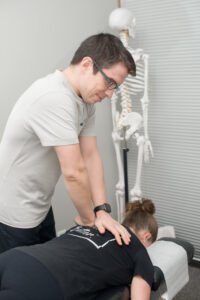
Dr. Andrew, DC
Chiropractic care focuses on diagnosing and treating musculoskeletal disorders, primarily through spinal adjustments. Through gentle manipulations, soft tissue therapy, and adjustments, chiropractors assist your body in healing itself and finding relief from discomfort.
The benefits of chiropractic treatment includes pain relief, improved range of motion, increased muscle strength, improved posture, and reduced stress. Chiropractic care can be especially beneficial for relieving back pain, neck pain, headaches, and sciatica. A chiropractor will also advise on lifestyle modifications to help support the effectiveness of the chiropractic treatments.
While chiropractors offer effective treatments, it’s important to consider a few factors. Spinal manipulation may carry a slight risk of adverse side effects. It’s extremely rare but possible to experience complications like worsening of a herniated disk or nerve compression. Additionally, some individuals may become reliant on regular visits to their chiropractor.
Chiropractic care may be right for you if …
- You suffer from chronic pain: Chiropractors can provide relief back pain, neck pain, and headaches and more. They focus on treating the source of the pain rather than just masking the symptoms.
- You want a natural approach to healing: Chiropractors use non-invasive, drug-free techniques that allow the body to heal naturally. Often, patients who want to avoid surgeries and medications prefer this approach.
- You want to improve your overall health: Chiropractic care is more than treating pain, it can also improve your overall health. Chiropractors can work with you to develop a wellness plan that includes nutrition, exercise, and other lifestyle habits.
- You want to avoid surgery: For many patients, chiropractic care can provide a safe alternative. Chiropractors can treat an array of conditions that might otherwise require surgery.
- You want to improve your athletic performance: Many professional athletes trust chiropractic care to help them achieve peak performance. Chiropractic care can improve flexibility, reduce injuries, and enhance overall athletic performance.
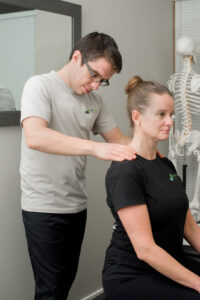
Dr. Andrew, DC
Chiropractic care may not be right for you if …
- You have a serious medical condition: Chiropractic care is not a substitute for medical treatment. If you have a serious medical condition, consult your doctor before seeking chiropractic care.
- You have a broken bone or fracture: Chiropractors do not treat broken bones or fractures. If you have a suspected fracture, you should seek medical attention immediately.
- You are pregnant: While chiropractic care is generally safe for pregnant women, choosing a chiropractor with experience treating them is crucial. You should also consult with your obstetrician before seeking chiropractic care.
- You have a herniated disc: Chiropractic treatment is effective for many back conditions, but it may not be appropriate for certain types of spinal injuries, such as a herniated disc. Your chiropractor can help you determine whether a chiropractic adjustment is the right treatment for your condition.
Physiotherapy:
Physiotherapy strives to help individuals regain movement and function after being affected by injury, illness, or disability. This is achieved through the use of different physical modalities, manipulation, mobilization, and exercises. Physiotherapy benefits include pain relief, improved joint mobility, muscle strength and function, balance and coordination, and increased endurance. Physiotherapy can be especially beneficial for sports injuries, musculoskeletal problems, neurological conditions, and post-operative rehabilitation.
It is important to note that physical therapy is not always a quick fix and may require weeks or even months to see noticeable results for some patients. The active nature of this form of rehabilitation necessitates patients’ active involvement, including doing exercises at home. A lack of commitment to these home exercises can prolong the rehabilitation process. Additionally, it is worth mentioning that physiotherapy has its limitations, particularly when addressing internal dysfunctions.
Physiotherapy may be right for you if …

Ed Middleton, PT
- You have an injury or condition that causes pain, stiffness, weakness, or limited mobility: Physiotherapists are experts in assessing and treating musculoskeletal and neurological conditions, such as back pain, arthritis, stroke, sports injuries, and post-surgical rehabilitation.
- You want to improve your physical performance or prevent injuries: Physical therapists can help athletes, dancers, and other active individuals fine-tune their bodies, optimize their movement patterns, and reduce their risk of getting hurt.
- You want to manage a chronic condition: If you have a lasting health challenge, such as diabetes, chronic pain, asthma, or heart disease, physical therapy can be a valuable part of your care team. Physiotherapists can help you learn self-management skills, cope with stress and fatigue, develop healthy habits, and enhance your quality of life.
- You want a non-invasive approach to healthcare: Many people prefer physiotherapy to other healthcare forms involving medication, injections, or surgery. Physical therapy is a natural and safe way to address health concerns without significant side effects or risks.
Physiotherapy may not be right for you if …
- You have a medical emergency or severe acute pain: If you have a life-threatening condition or sudden severe pain, you should seek immediate medical attention from a hospital or emergency department. Physiotherapy is not a substitute for urgent care; physical therapists do not provide medical diagnosis or emergency treatment.
- You have a condition or injury that requires specialized medical or surgical attention: In some cases, physiotherapy may not be able to replace or avoid surgical or medical interventions. For example, if you have a tumour, you may need surgery first and then physiotherapy to support your recovery.
- You have a personal or cultural preference for other forms of healthcare: Everyone has different beliefs, values, and preferences when it comes to healthcare. If you do not believe in holistic approaches like acupuncture, chiropractic, or naturopathy, physiotherapy may not align with you.
- You are not ready or motivated to participate in the treatment: Physiotherapy requires active participation from the patient to be effective. If you are unwilling or unprepared to engage in the treatment, such as attending appointments, doing exercises, following instructions, or communicating with your physiotherapist, you may not benefit as much as possible.

Cranial Sacral Therapy
Manual Osteopathy:
Manual osteopathy, on the other hand, focuses on the manual manipulation of the body’s musculoskeletal and visceral systems. Visceral manipulation is a hands-on therapy that targets the internal organs, addressing functional and structural imbalances within multiple body systems. Visceral manipulation can address dysfunctions caused by both physical and emotional factors.
The benefits of manual osteopathy include pain relief, improved range of motion, digestion, blood flow, organ function, sleep, and reduced stress. With its roots in indigenous medicine, bodywork and healing arts, manual osteopathy can be especially beneficial for conditions like chronic pain, digestive problems, irritable bowel syndrome, menstrual pain, bladder problems, anxiety, depression, migraine headaches, and hormonal imbalances.
Manual osteopathy also has limitations, such as long-term commitments due to gradual, gentle manipulations. Not all healthcare practitioners recognize it, and finding a practitioner who practices it in some areas can be challenging. Additionally, some health insurance plans do not cover or allow direct billing for manual osteopathy, which can lead to more significant out-of-pocket expenses for some patients.
Manual osteopathy may be right for you if …
- You experience chronic pain: Manual osteopathy is an effective method of pain relief for headaches, back pains, and neck pains. If you are tired of relying on medication to cope with your pain, manual osteopathy could be the solution.
- You prefer non-invasive treatments: Unlike invasive treatments like surgery or injections, manual osteopathy is a non-invasive therapy that involves hands-on techniques.
- You’re looking for a holistic treatment: Manual osteopathy focuses on the body as a whole. Therapists diagnose and treat the root cause of your problems, not just the symptoms.
- You want to improve your overall well-being: Manual osteopathy is known for balancing the body’s natural rhythm and facilitating the body’s capacity to self-heal.

Gagandeep Watts, MO
Manual osteopathy may not be right for you if …
- You’re facing a medical emergency: Manual osteopathy is not a substitute for emergency medical care. If you are facing a severe medical emergency, seek medical attention immediately.
- You have an acute illness: Manual osteopathy is ineffective for acute illnesses like flu, viral infections, and bacterial infections. In such cases, you may need to receive conventional medical care.
- You have broken bones: Manual osteopathy is not the correct treatment if you have broken or fractured bones. You will need to see an orthopedic surgeon for medical assistance.
- You are pregnant: It is necessary to speak with your doctor before undergoing treatment. Although manual osteopathy is generally safe, it is important to consult your doctor before considering it.
Conclusion:
Choosing the treatment that is right for you is important. Whether you decide on chiropractic care, physiotherapy, or manual osteopathy, each offers a unique approach to helping alleviate pain, restore function, and promote optimal health. The choice often comes down to personal preference and what type of issue you’re dealing with. It’s always a good idea to research and seek recommendations when choosing a healthcare professional to ensure they’re qualified, experienced and are right for you. A combination of these therapies may be beneficial for achieving optimal health and wellness.
Do you still have questions? Click here to book a free 15 minute consultation.
Written by: DeVera Nybo, MBA

Therapy Options Explained
As the owner of Newleaf Total Wellness Centre in Abbotsford, I am often asked if hypnosis can really be considered therapy. The answer is a resounding YES! Hypnotherapy is a holistic approach to treating many physical and mental health conditions. Initially, the idea of hypnotherapy seems mysterious and, to some extent, intimidating. However, it is a well-respected albeit unregulated therapy practiced by certified professionals. While the use of hypnosis by certified hypnotherapists has gained greater acceptance in mainstream healthcare, one must understand that hypnotherapy is not a one-size-fits-all technique. People have different personalities, temperaments, and emotional regulation, which affect the success of hypnotherapy. This article will explain hypnotherapy and what happens during a session to help you make an informed choice for your therapeutic needs.
What is Hypnotherapy?
Hypnotherapy is a type of talk therapy that involves entering an alpha/theta brain wave state, which occurs naturally during sleep. Its purpose is to make lasting positive changes in your thoughts, emotions, and behaviours. By combining talk therapy with therapeutic hypnosis, hypnotherapy creates a safe and supportive environment to bridge the gap between conscious intentions and subconscious motivations. You can begin to align your thoughts and actions with your desired outcome. Typically, each hypnotherapy session lasts around an hour, and patients often see noticeable improvements within two to ten sessions. However, the required sessions can vary depending on individual needs and goals.

How hypnotherapy works
What can Hypnotherapy Treat?
Hypnotherapy has been extensively researched and is proven to help individuals manage stress, anxiety, irritable bowel syndrome, PTSD, and the behavioural issues experienced by children with autism. Hypnosis also provides a practical solution for pain management without any side effects, which is especially important in light of the growing concerns around opioid addiction.
In addition to pain control and behaviour change, hypnotherapy holds promise in addressing mental health conditions, treating asthma and alleviating the side effects of cancer treatment. This versatile approach extends to breaking free from the fight, flight or freeze response.
However, it is important to note that hypnotherapy may not be suitable for people with severe mental health issues or those under the influence of drugs or alcohol. Furthermore, experts advise against using hypnosis for memory retrieval. Remembering the past is essentially a form of storytelling, as our memories depend on the last story we tell ourselves. Consequently, individuals hoping to recall childhood events should be cautious of creating false memories through hypnotherapy.
How does it Work?
By accessing the power of your subconscious mind, hypnotherapy allows you to rewrite the code of your mental programming. The conscious mind only controls a small portion of your overall well-being, while the subconscious accounts for a staggering 88%. Hypnotherapy helps reframe your subconscious mindset to align with your goals and dreams.

Hypnotherapy session
What happens in a session?
Stage One – Introductions and Goal Setting
During your first session, your hypnotherapist will get to know you, your reasons for seeking hypnotherapy, and your experience with therapy in general. They will ask about your medical and mental health history, the symptoms you are experiencing, any medications you are taking and your goals for therapy. This information is crucial for the hypnotherapist to create a customized plan for your treatment. Once your hypnotherapist has gathered initial information, they will explain how hypnotherapy works. They will describe the hypnosis process, what will happen during the session, how you may or may not feel, and what to expect after the session. It’s essential to ask all your questions now to ensure you feel fully informed, comfortable and relaxed before your session.
Stage Two – Hypnosis and Conversation
The hypnotherapist will lead you into a relaxed state, similar to meditation, by having you imagine yourself in a relaxing, peaceful place, allowing your mind to support your body in deep rest. With your eyes closed, you’ll remain fully alert as they guide you through the session. Focusing on your breath, you’ll release stress and tension, entering a state of deep relaxation.
Once you have achieved a hypnotic state, the therapist will guide you on a visual journey to release negativity and incorporate positive changes. Through heartfelt discussions between your protected self and these vulnerable aspects, some discover a transformative experience. The intention is to forge a new relationship within yourself, building a foundation for growth and healing guided by love and protection.
This process involves suggestions to replace unfavourable trance states with more desirable ones. The therapist may also help you reframe negative experiences or memories so that they are no longer a source of stress or anxiety. You may feel lightheaded, relaxed, or even fall asleep during the session. Some patients report being amazed by the intensity of the beautiful emotions they experience in this state. These experiences are normal and to be expected.
It’s important to remember that the hypnotherapist will never ask you to do anything outside of your comfort zone or beliefs, and you will be in complete control throughout the process. Many patients describe hypnosis as a state of deep relaxation and heightened awareness. If, at any point, you feel uncomfortable or wish to stop, you can simply open your eyes and speak with your hypnotherapist. Communicating any feelings that arise is crucial, as this is the only way your therapist can make adjustments for subsequent sessions.
Stage Three – Ending the Session
Before bringing you back to full awareness, the hypnotherapist will often offer positive suggestions and allow you to address any remaining concerns. Your consent is of utmost importance, and a good hypnotherapist will include the suggestion, “No one, including myself, will be able to hypnotize you without your consent.” After the session, you will slowly come out of the hypnotic state and may feel more relaxed, energized, or the same as before. The therapist will conclude the session by discussing your experiences and observations. Before you leave, the therapist may also provide you with activities to do that support ongoing self-love and growth or self-hypnosis techniques to try on your own. In any case, you must practice self-reflection and self-care after the session.
Conclusion
Hypnotherapy may serve as a powerful tool for enhancing well-being, alleviating anxiety, and transforming negative behavioural patterns. Nevertheless, certain patients may experience restlessness, anxiety, or difficulty reaching an alpha/theta state, which can impact the effectiveness of hypnotherapy. It’s important to note that successful therapy relies heavily on the rapport between the client and therapist, with rapport accounting for more than 70% of therapy’s efficacy. It is essential to consider all your therapy options and find a therapist whose personality and technique suit your specific needs.

Ashlee Bennett
Do you still have questions? Book a 15 minute FREE consultation with our Hypnotherapist, Ashlee by clicking HERE.
Written by: DeVera Nybo



























































































































